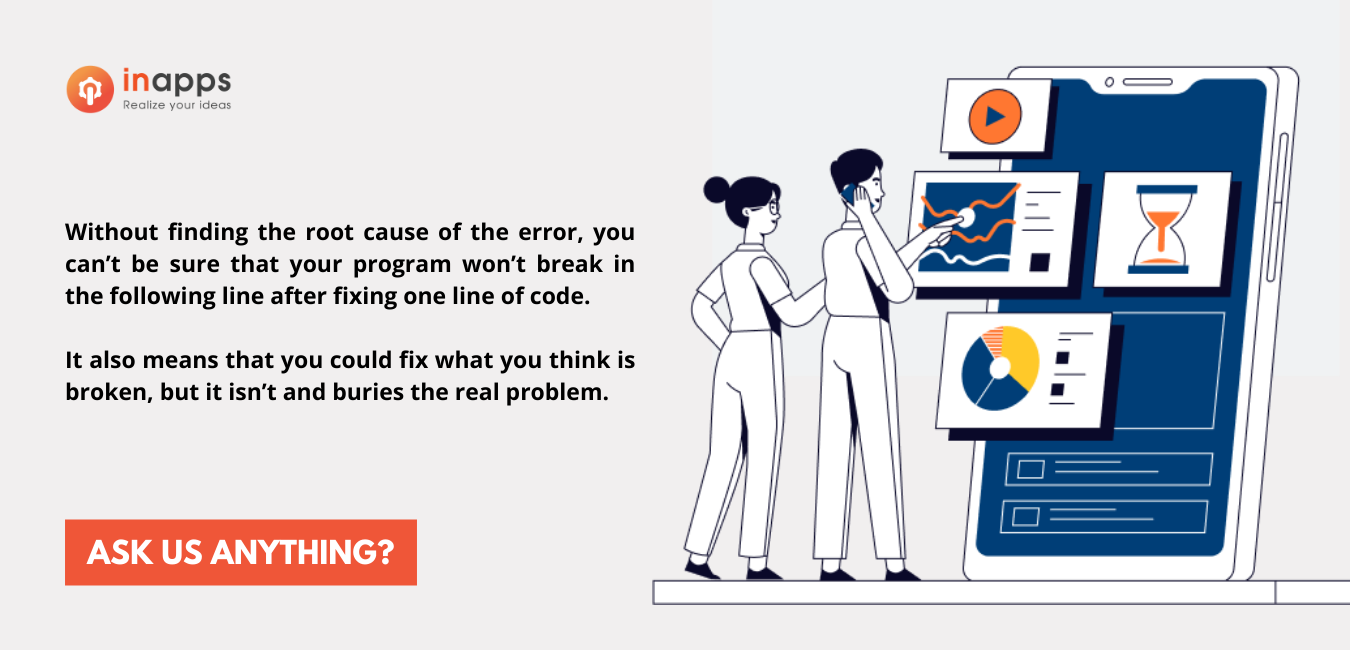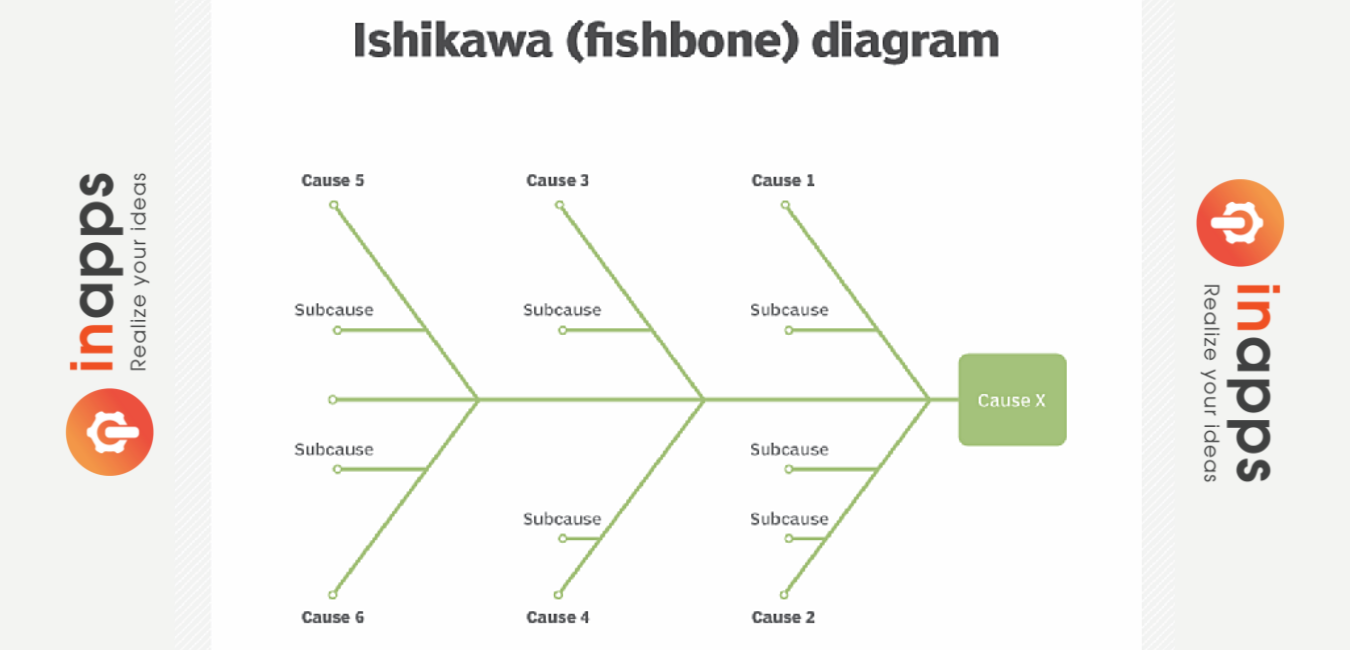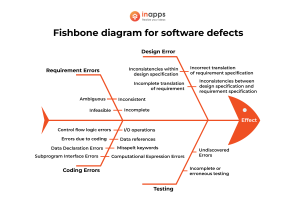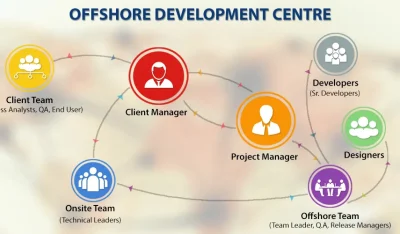- Hire Full Project Team
- Hire Fullstack Engineer Team
- Hire Quality Assurance Team
- Mobile App Development
- Web App Development

- Blockchain development
- E-commerce development
- Booking Platform
- Marketplace

- Web Backend Development
- Web frontend development
- Blockchain Software Development

- Partnership
- Free Proposal
- Offshore News

Mastering Proactive Problem Solving: A Guide for Today’s Tech Companies

Main Contents:
Today’s tech companies face many challenges, such as rising expectations from users, fast changes in technology, and tough competition. Because of this, managers and IT professionals often focus on using technology for proactive problem solving.
However, many companies still don’t have a clear plan to handle issues effectively. They need to find the main causes, fix them, check the results, and learn how to do their jobs better every day. This is where good strategies for proactive problem solving are important.
To avoid problems, it’s crucial to be ready for any situation. This blog post will talk about the importance of proactive problem solving and how to do it quickly, creatively, and permanently.
1. What is proactive problem-solving?
Proactive problem-solving is a strategy that focuses on preventing issues before they arise. It targets the root causes of potential problems rather than merely addressing their symptoms. This approach emphasizes planning and taking preventive measures well in advance.
In a practical setting, a proactive development team doesn’t just react to issues as they come. Instead, they actively seek out potential challenges and address them early on. This proactive approach ensures that every team member is prepared to handle unexpected issues. They are trained extensively and always have a contingency plan ready.
The advantages of proactive problem-solving are manifold. Firstly, it minimizes disruptions, maintaining the team’s productivity and output. Secondly, it allows the organization to stay ahead of the competition by mitigating risks before they can affect the workflow. This not only leads to higher client satisfaction but also contributes to the long-term success and resilience of the team.
2. How to build a proactive problem-solving team

Problem-solving teams are created to work together permanently
2.1 Identify root causes
Identifying root causes is a crucial step in proactive problem-solving. When a team pinpoints the fundamental cause of a defect, they can fix it directly and prevent it from recurring.
For instance, in proactive problem management, if a defect stems from a design error, developers can scrutinize the design and requirements documentation to make necessary corrections. Similarly, if the defect arises due to a mistake in testing, developers can refine the test cases and metrics.
Thus, a team skilled in proactive problem-solving is adept at recognizing and addressing the root causes of issues. This ability is key to preventing future problems and enhancing system reliability.
Types of defect
- Errors, Omissions, or Gaps in the Original Requirements: These defects can occur if a requirement is overlooked or incorrectly written. They also arise when the needs of stakeholders are not fully understood or when there is a miscommunication with developers.
- Errors in Design or Architecture: These issues happen when software designers create an inefficient algorithm or process. Problems also arise if the algorithm does not deliver results with the required accuracy.
- Errors in Coding or Implementation: These include traditional bugs that can result from anything from missing brackets to inadequate error handling.
- Errors in Test Planning or Test Execution: These defects occur due to inadequately tested features and functions, leading to unresolved issues in the final product.
- Errors in Deployment: An example of such a problem is allocating insufficient VM resources, which can lead to performance issues.
- Errors in the Processes or Policies Governing the Development Cycle: These defects can emerge when teams get sign-offs or approvals without thorough reviews in design, coding, or testing.

How to implement proactive problem management process
Approaches to root cause analysis

The Fishbone diagram is one of the most popular techniques.
A fishbone analysis , also known as an Ishikawa diagram or a cause-and-effect diagram, is intended to assist analysts in visualizing a root cause by categorizing potential reasons into categories that branch out from the initial issue. The resultant graphic resembles a fish skeleton, thus the name.
The underlying problem or issue is usually written at the “head” of the fish. The “bones” are categories of possible causes. Then we can find out the principal reasons under each group; if necessary, the diagram might include secondary and tertiary factors.

Use fishbone diagram to identify root causes of software defects
Learn more: When do you need to hire a professional software QA team?
2.2 Proactively determine solutions
Once the issue is identified, it’s crucial to develop a solution. It’s easy to become overly focused on identifying issues, sometimes neglecting the importance of crafting solutions.
When addressing a problem, consider two key factors: resolving the issue and preventing its recurrence. We’re all familiar with “hotfixes” that become permanent and accumulate technical debt.
To begin, solutions should be discussed among team members to ensure everyone understands the issue from the stakeholders’ perspectives and connects the solution to their pain points. Proactively communicating with stakeholders early in and throughout the implementation process helps build trust and enthusiasm for the solutions proposed. This ongoing dialogue is vital for aligning the team’s actions with stakeholder expectations and ensuring the effectiveness of the solutions.
2.3 Empower open communication and ongoing feedback
Proactive problem-solving begins with getting everyone on the same page about an overall plan for how you’re going tackle the project. This includes setting specific goals and objectives. Hence, communication is key here. Be sure that everyone knows their role and what they are expected to do throughout the entire project life cycle.
The evolution of management is an ongoing process of open communication and feedback. Team members will receive the support needed for any improvements or changes in direction from management if necessary.
- Feedback from all members of the development group should be given regularly, even if it’s negative or positive. Developing a clear feedback process with the team puts everyone on the same playing field for future progress.
- Encourage open communication among peers by making space for discussion in meetings. The team may focus on what went right and wrong in a productive and non-occupational way through meetings.
- Encourage members of the team to ask questions. Never disregard a question or make someone feel insufficient for posing one. Questions contribute to critical explanations, discoveries, and, in many cases, process improvements that the team would not have identified otherwise.
4. Characteristics of InApps’ proactive problem-solving team
We win our client’s trust with high skills, market knowledge, well-communication, and 24/7 dedicated support.

Proactive Problem Management
4.1 Flexible approach
We provide each of our clients with a unique custom solution. We always have meetings to deeply understand our client’s business models and requirements or the pain points before making the proposals.
With InApps, clients can participate in projects by prioritizing, defining functions, developing iteration plans and reviews, and developing software versions that incorporate new features.
4.2 Proactive support
We handle issues and fix urgent to minimize complaints. Our software development team uses platforms like Slack for internal conversations between meetings. When we require the client’s feedback, we use technologies like Basecamp to facilitate communication proactively.
This is also useful if the client needs to bring anything to our notice for discussion. We can communicate, ensure information is distributed, and plan spontaneous conversations to walk through more complex issues.
4.3 High troubleshooting skills
Need to fix bugs to launch your web/app as soon as possible? We offer dedicated teams with proactive troubleshooting skills to quickly fix all your urgent issues. Trust and high technical skills are the factors that made InApps build a successful high-performing offshore team .
4.4 Rapid response & quickly fix all urgent issues
We have a unique program to train talents to become a SWAT team that works effectively with clients. Our offshore team quickly solves the problems from the root causes and responds to the client within 24 hours.
Read more: InApps’ Automation Management: Proactive Solution for Software Development

Let’s create the next big thing together!
Coming together is a beginning. Keeping together is progress. Working together is success.
Let’s talk
Recommended

Hire Offshore Mobile Development To Build Next-level Apps

Top Python Projects for Beginners with Python

Setting Up Vietnam Offshore Development Centre Service

Complete Guide To Hiring Top Offshore Net Developers

Hire Qualified Offshore Shopify Developers From Vietnam

How To Hire Offshore WordPress Developers From Vietnam

How to Hire Offshore Python Developers From Vietnam

Key Steps to Hire Offshore AngularJS Developers

Offshore Product Development and How It Differs?

Hire The Right Offshore Development Team In Vietnam
Get a custom proposal.
Please fill in your information and your need to get a suitable solution .
Business Email Your name Phone number How can we help?
Retail & E-commerce Food Ordering App Blockchain AI Healthcare Hospitality Travel & Tourism Real Estate Education & E-Learning Online Flatform Others
20K to 50K 50K to 100K More than 100K Need a Consultant
Upload your specs...
I accept the privacy policy Send me an NDA Call me ASAP
You need to enter your email to download
Email Your name Phone
I accept the privacy policy
9 Practical Tips to Choose a Mobile App Development Company for 2023
Picture this: You finally decide to build a mobile application, as a solution to drive your business growth. However, you then have to choose the right mobile…
HOURLY RATES FOR APP DEVELOPERS COMPARE ON ALL FACTORS
The hourly rate is one of the most important decision factors when hiring a developer. It varies on location, technology stack, skill level, programming language, etc. So how…
The global mobile application market was valued at USD 252.89 billion in 2023 and is expected to grow at a compound annual growth rate (CAGR) of 14.3%…
Best ReactJS Projects for Beginners
Do you want to build your own app using front-end frameworks? Begin learning ReactJS with zeal, and you can get your app to the top of the…
Ho Chi Minh (Headquarter)
Singapore Branch

More From Forbes
15 tips to become a proactive business problem-solver.
- Share to Facebook
- Share to Twitter
- Share to Linkedin
While every business has problems, the solutions that you use to solve these issues is what really matters. As a working professional, it can be easy to react rather than prepare for the challenges your business faces. Having a plan in place that proactively takes the reins and addresses these problems can make a difference in how well equipped you are to handle and manage these situations without any interruption in your business’ operations.
Below, 15 members of Forbes Coaches Council share the best tips for planning ahead so that you are proactive rather than reactive when it comes to solving problems at work. Here’s what they recommend:
Members discuss ways to stay ahead of problems.
1. Reflect With Others
I engage others on a regular basis to discuss what we should continue doing, stop doing or start doing. Being proactive requires an understanding of reality by managing perceptions. This means getting feedback and actively seeking solutions, no matter how small. Set up regular reflections with individuals or teams. - Alan Trivedi, MBA PCC , Trivedi Coaching & Consulting Group
2. Research And Anticipate
Take time to research projects fully -- not only in regards to execution but also how they fit into broader strategic goals. This will give you additional insight that will allow you to anticipate potential needs and opportunities that may not be immediately evident and get out in front of them. - Tonya Echols , Thrive Coaching Solutions
3. Use The Buffer Technique
An admin used to schedule back-to-back meetings, sometimes including those with a drive to get there. Even if I kept up, I was always rushed. Now all meetings and focused activities have "buffer time" --15 or 30 minutes, unscheduled, in between meetings. This allows for meetings that go over, time to get a snack or time to drive and arrive relaxed and early. Put the buffer between meetings. - John Hittler , Evoking Genius
4. Seek Feedback From Co-workers
Get to know the people on your team and ask them about what they find difficult or challenging in their jobs. See if you can get them to pinpoint an area where they need support on a particular project, with a client or on an assignment. Once you understand their pain points, offer your support and follow through with helping them tackle their challenges. - Beth Kuhel , Get Hired, LLC
5. Train Unemotionally
Most problems aren't new. You have seen this movie. When you are in the problem, the crisis, you react emotionally. You are living it. As an EMT, you know how to stem the flow of blood safely. You were trained by the book. Similarly, in your business and life, you can train and create ways you will handle a problem client on any issue or a product setback. Write that SOP now before the emergency. - John M. O'Connor , Career Pro Inc.
6. Have Systems And Processes
Staying organized with systems and processes allows you to anticipate issues or be ready to handle any issues that arise unexpectedly. With systems in place, you can notice when a project isn't aligning and more quickly catch a potential issue. With processes to follow, people can know when a modified step provides better results for a finished project. - Rosie Guagliardo , InnerBrilliance Coaching
7. Use The Decision Tree Method
A sure way to anticipate and be prepared for potential issues is to understand and utilize the"decision tree" methodology. Think of it as playing out different outcomes based on different decisions. If you apply it consistently to all major decisions, you will very likely be able to be proactive when potential issues arise. - Kamyar Shah , World Consulting Group
8. Separate People From The Problem
Focusing on the problem rather than the personalities behind it helps us find win-win solutions without devolving into personal attacks. Focusing on sharing information and building relationships prepares us for the inevitable challenges that come up at work. This will always be a more constructive approach to solving problems and leveraging power than wielding it like a club. - Tracey Grove , Pure Symmetry Coaching and Consulting
9. Ask The Right Questions
Great leaders ask great questions. Many leaders cannot plan ahead because they cannot think about the questions that they should be asking themselves or their teams. Every month, pause to ask yourself the right questions that will lead you to working on the right things for the future and not just for the urgent. - Ken Gosnell , CEO Experience
10. Develop A 100-Day Plan
Planning ahead requires you understand what types of challenges your team is facing. Spend time on the floor observing, listening and talking to your team. Then, use a 100-day calendar, with 10-day increments, and map out what is due and what might come up. Make this visible so everyone can be prepared. This helps your team learn to review, revise and think ahead. - Cynthia Howard RN, CNC, PhD. , EI Leadership
11. Stay Organized
Staying organized is key to being proactive and keeping things under control. Being organized is a delicate balance between managing your time and not being a slave to it. Develop an organizational system that works for you and fits your personal style. Then use it. Create "footballs" for projects and team engagements so you can dedicate time to proactive discussions and critical thinking. - Tony Mickle , Big Box Coaching
12. Remember 'Busy' Is A State Of Mind
I do everything in batches by task instead of being victim to my to-do list or inbox. If I am writing or focusing on a strategic piece, I log out of email and turn off Wi-Fi and put my phone on "do not disturb." I commit to spending 50% of my time on working in the business and 50% of my time working on the business (strategy). I remind myself that being overly "busy" isn't a sign of achievement or success. - Courtney Feider , Courtney Feider, LLC
13. Focus On The Important, Not Just The Urgent
It's easy to get caught up in the firefighting, but to be proactive, you need to find some time for fire prevention. Review everything that you work on; not everything that is urgent is important. Learn to delegate the non-important work or even eliminate it, if possible. This will help take you out of reactive mode and give you the opportunity to focus on just the important and be proactive. - Gordon Tredgold , Leadership Principles LLC
14. Use Walt Disney's Planning Strategy
I love to use Walt Disney's strategy to planning. He would have three chairs in his office that represented a different perspective to view any idea. In the Dreamer chair, he would allow himself to create visions without constraints. In the Realist chair, he would consider the resources available to him. And, finally, in the Spoiler chair, he would consider all the pitfalls and plan accordingly. - Carolina Caro , Carolina Caro
15. Be Deliberate
To be proactive, you must own the situation. Detail how time is utilized and include time for strategic thinking where you look to the future and learn from the past. Make notes about where you want the organization to go, how to lead, and learn from others by reading their journeys. This simple, deliberate act drives continuous improvement to prepare you for the situations to come. - Chris Stricklin , Afterburner
- Editorial Standards
- Reprints & Permissions
Project Management
The Undeniable Benefits of Proactive Problem Management

Max 7 min read

Click the button to start reading
Do you ever go through periods at work that feel like a constant game of whack-a-mole? Just when everyone swarms to solve one problem, a new one surfaces, and you never get a chance to clear your head and get anything in order.
Proactive problem management is about rooting out some of these “work surprises,” and putting together a system and strategy for solving and preventing problems. It’s also helpful in developing a business strategy.
Let’s briefly define proactive problem management with examples, then discuss its benefits and how to implement it into the workplace.

What is Proactive Problem Management?
We’re presented with so many rapid changes and problems in the workplace, and wrangling them all requires some finesse. Proactive problem management is one facet of a successful strategy.
The Information Technology Infrastructure Library (ITIL) codified many of the concepts around problem management with clear terms and definitions. Let’s look into their definition of proactive problem management, and some of the key terms surrounding it.
An incident is anything that disrupts the regular workflow or the performance of equipment. It can also mean a decline in performance, such as a weak internet signal.
A problem is an incident where the cause isn’t known. Addressing a problem requires an investigation into the cause.
Let’s distinguish between an incident and a problem. An incident is something that happens, let’s say an email bounces. A problem is when the cause of the incident isn’t known; so the reason for the bounce is unclear.
Reactive problem management is the process for addressing a problem that has already occurred. This is the most common form of problem management. After investigating the cause of the problem, a team often swarms together to fix it.
Proactive problem management is about anticipating potential problems and preventing them. It entails looking at data and incident reports to identify trends and patterns, then putting systems into place to preclude or prevent incidents. It’s very similar to the risk management concept of mitigating controls .
Event Management Process is the system for monitoring proactive project management. It’s about stopping a problem before anyone is even impacted by it.

Examples of Proactive Problem Management
With these definitions in mind, let’s look into a few examples of proactive and reactive problem management, to see what they look like in real life.
A Doctor Visit
Let’s say you go to see the doctor about a stomachache, and he or she examines you, diagnoses it as an infection, then prescribes some antibiotics to treat it.
In this scenario, the stomachache is the problem, as you don’t know what caused it. The doctor’s investigation into the root cause is an example of reactive problem management.
On another occasion, you visit the doctor for a checkup, and everything looks fine. As part of the checkup, the doctor advises you to eat well, take vitamins, and exercise.
In this scenario, there was no incident. However, steps were taken to prevent one from happening, with the doctor’s advice for healthy living. And so this is an example of proactive problem management.
Now, let’s look at a workplace problem. Let’s say a remote team is having a meeting on a conference platform, and the audio stops working halfway through.
At this point, the IT team swarms around the problem to identify the cause and fix it. This is reactive problem management.
Over the next few days, the IT team does its due diligence, investigating what caused the audio to fail and putting preventative measures into place. The very next week, the team has the same meeting, and everything proceeds without a hitch.
This is an example of proactive problem management: there was no incident, as preventative measures were taken to keep one from happening.
As you can see, proactive problem management is about researching and addressing causes before they have a chance to happen. And reactive problem management means rooting out the cause of an incident that has occurred, and fixing the problem.

How to Implement Proactive Problem Management
Implementing proactive problem management is about planning, brainstorming, and looking ahead. It also entails collecting data and identifying patterns.
Proactive problem management benefits any department within an organization, not simply IT. Let’s look at a few ways to implement it into the workplace.
Track Data on Problems and Incidents
For most departments, particularly IT, you tend to see the same incident over and over again. Proactive problem management looks at what you’re doing to reduce these incidents.
Reactive problem management plays an integral role in putting systems in place to prevent further hangups. After a team has investigated a problem and identified the cause, they’ve developed a system. Codifying this system is a central component to mitigating and reducing incidents.
Keeping data on problems is important, too. By knowing the frequency of incidents, and when and where they occur, it’s possible to create procedures. Understanding which incidents occur the most frequently also helps with resource allocation.
Research and Know Customers
Customer needs change so rapidly with market trends that it’s necessary to constantly refresh and update products in order to meet these needs.
A proactive approach to product development means brainstorming ideas in light of current and anticipated trends. This forward thinking results in a product that serves customers, and prevents creating something that’s irrelevant or outdated.
Promote a Mindset of Growth
A company culture can cultivate a proactive approach to problems as well. When a culture is open, welcomes debate, and listens to feedback and constructive criticism , it creates an environment where people are making improvements all the time.
One effective process for developing a proactive culture is with a weekly meeting, where everyone reflects on the activity of the week, and brainstorms ways to improve processes, products and services.
In sum, proactive problem management is helpful in many parts of an organization. It benefits the operations that allow people to communicate and use equipment. It also benefits the product and services a business produces.

Benefits of Proactive Problem Management
Proactive problem management is a systematic approach to reducing the interruption of workflow. Let’s look at some of the ways it benefits an organization.
It Reduces Incidents
Most clearly, proactive problem management keeps systems running smoothly. It’s about looking ahead to things that might happen, and then avoiding or reducing the occurrence.
When organizations utilize proactive problem management, people don’t even realize they’re avoiding problems. Meetings run smoothly, the internet works, and a business consistently produces a solid product or provides top-notch service.
The Work Day is Predictable
When a department exclusively uses reactive problem management, it’s constantly swarming around one problem and then another. It forces a team to work on whatever fire happens to be burning at the moment.
Proactive problem management, on the other hand, is systematic.
It’s easier to know what to expect from a workday when energy is geared toward researching data and putting processes into place, rather than playing whack-a-mole.
A Time Saver
Have you ever noticed that the first time you do something, it takes forever, but then after you’ve done it a dozen or so times, it takes way less time?
Reactive problem management is about solving a problem for the first time. For this reason, it tends to be a time-consuming process.
With proactive problem management, on the other hand, a system has been put into place (thanks to the knowledge gained from reactive problem management). And so you’re doing something that you’ve already done many times before, which uses up much less time and energy.
You’re also not going out and fixing things, as many problems don’t happen in the first place.
As you can see, proactive problem management brings a lot of order into a workplace, so it’s definitely a boon to any department.
Proactive problem management is one approach for addressing problems. It is used in IT, company operations, product strategy and anywhere, really.
Developing the systems and processes for proactive problem management leans heavily on investigating and solving existing problems. It’s also important to collect data, in order to understand which problems occur the most frequently.
We see proactive problem management wherever we go. Even a stop sign alerts us to prevent the possible incident of hitting another car.
The forward-thinking aspect of proactive problem management allows an organization to run smoothly. People fix problems before they even start.
#ezw_tco-2 .ez-toc-title{ font-size: 120%; ; ; } #ezw_tco-2 .ez-toc-widget-container ul.ez-toc-list li.active{ background-color: #ededed; } Table of Contents
Manage your remote team with teamly. get your 100% free account today..

PC and Mac compatible

Teamly is everywhere you need it to be. Desktop download or web browser or IOS/Android app. Take your pick.
Get Teamly for FREE by clicking below.
No credit card required. completely free.
Teamly puts everything in one place, so you can start and finish projects quickly and efficiently.
Keep reading.

7 Unbeatable Ways To Stay Organized At Work (And Boost Your Profits!)
7 Unbeatable Ways To Stay Organized At Work (And Boost Your Profits!)A report by The Wall Street Journal revealed that the average executive in the United States wastes approximately 6 weeks per year searching messy desks to find misplaced information and files! That adds up to a total of $9221 each year for an executive …
Continue reading “7 Unbeatable Ways To Stay Organized At Work (And Boost Your Profits!)”

8 Powerful Tips to Help You With Organizing Your Business
8 Powerful Tips to Help You With Organizing Your BusinessIs your business set up for maximum productivity and free of anything that could cause you stress or anxiety? If you can honestly answer yes, then this article isn’t for you. However, if you’re answer is no, that’s okay. There are plenty of things you can …
Continue reading “8 Powerful Tips to Help You With Organizing Your Business”
Max 5 min read

Mastering the Art of Project Monitoring for Successful Outcomes
Mastering the Art of Project Monitoring for Successful OutcomesEvery project manager has experienced one, if not all, of these pains: That moment when, despite the best-laid plans, the project starts to veer off course. The deadline that was once far away now looms dangerously close. Cost estimates are steadily creeping upwards. The once enthusiastic team …
Continue reading “Mastering the Art of Project Monitoring for Successful Outcomes”
Max 9 min read
Project Management Software Comparisons

Asana vs Wrike

Basecamp vs Slack

Smartsheet vs Airtable

Trello vs ClickUp

Monday.com vs Jira Work Management
Trello vs asana.
Get Teamly for FREE Enter your email and create your account today!
You must enter a valid email address
You must enter a valid email address!
30 Proactive Approach Examples & Why It Matters
Dec 3, 2023

In this article, we delve into 30 actionable examples showcasing the power of a proactive mindset, illustrating how this approach significantly impacts work, business endeavors, and overall life achievements.
Being proactive isn’t just a buzzword – it’s a transformative mindset that propels individuals toward their goals. Throughout this piece, we’ll explore a myriad of real-world instances where proactive thinking and action have made an undeniable difference. From proactive problem-solving strategies to proactive communication techniques, each example is meticulously curated to highlight its relevance in fostering success. Understanding and implementing these approaches not only enhance productivity in the workplace but also pave the way for resilience, adaptability, and substantial progress in various facets of life. Join us on this journey as we uncover the essence of proactive approaches and why mastering this mindset is fundamental in navigating the complexities of modern work dynamics and personal aspirations.
The Best Proactive Approach Examples
1. Setting Goals Setting clear, achievable objectives is the cornerstone of progress. By defining these goals and crafting actionable plans to attain them, individuals and organizations steer their energies toward specific outcomes. This proactive approach provides direction, motivation, and a roadmap for success. It not only sharpens focus but also fosters a sense of purpose, enabling better decision-making and resource allocation.
2. Innovation and Creativity Encouraging a culture of innovation and creativity sparks progress. Embracing new ideas and unconventional thinking cultivates an environment ripe for growth and evolution. By constantly seeking ways to improve products, services, or processes, individuals and companies can stay ahead in competitive landscapes, driving meaningful change and differentiation.
3. Continuous Learning The commitment to ongoing learning and skill development is a proactive strategy that fuels personal and professional growth. Embracing new knowledge, trends, and advancements in your field ensures relevance and adaptability. It’s about staying curious, exploring new horizons, and being open to evolving perspectives, ultimately enhancing expertise and staying at the forefront of your industry.
4. Risk Assessment Identifying and mitigating potential risks before they escalate is a proactive measure that safeguards against unforeseen challenges. By conducting thorough risk assessments, individuals and organizations can develop strategies to anticipate, minimize, or even eliminate these risks. This approach fortifies resilience and bolsters preparedness in navigating uncertain terrain.
5. Streamlining Processes Regularly evaluating and optimizing workflows is a proactive endeavor that drives efficiency. By continuously refining operational processes, businesses can eliminate redundancies, reduce wastage, and enhance productivity. It’s about fostering a culture of efficiency and agility, ensuring that resources are utilized optimally to achieve desired outcomes.
6. Building Relationships Initiating and nurturing meaningful connections is a proactive approach that forms the bedrock of collaboration and support. By actively cultivating relationships with colleagues, clients, and mentors, individuals foster a network that not only offers guidance but also opens doors to opportunities, collaboration, and mutual growth.
7. Crisis Planning Developing contingency plans and protocols for unforeseen situations is a proactive strategy that minimizes the impact of crises. By anticipating potential emergencies and having well-thought-out plans in place, individuals and organizations can respond swiftly and effectively, mitigating damage and ensuring a smoother recovery process.
8. Financial Planning Prudent financial planning involves budgeting, saving, and investing wisely to secure future stability. By taking a proactive stance towards managing finances, individuals can build a robust financial foundation, mitigate risks, and work towards achieving long-term financial goals.
9. Succession Planning Identifying and nurturing future leaders within an organization is a proactive measure that ensures continuity and growth. By grooming talent and preparing individuals for leadership roles , businesses safeguard against leadership vacuums and enable a seamless transition, fostering sustainability and organizational resilience.
10. Conflict Resolution Addressing conflicts proactively is essential for maintaining healthy relationships, both personally and professionally. By confronting issues early and seeking resolutions that satisfy all parties involved, individuals can prevent escalation, foster understanding, and maintain a conducive environment for collaboration and growth.
11. Team Empowerment Empowering team members by fostering an environment of trust and autonomy is a proactive approach that cultivates a sense of ownership and responsibility. Encouraging individuals to make decisions independently not only boosts their confidence but also enhances productivity and creativity within the team. This approach fosters a culture where each member feels valued, leading to increased engagement and innovative problem-solving.
12. Technology Adoption Staying abreast of technological advancements and integrating relevant tools into workflows is a proactive strategy that drives efficiency and competitiveness. Embracing new technologies helps streamline processes, reduces manual effort, and often opens avenues for innovative solutions. It’s about embracing change to optimize operations and deliver enhanced value to customers or clients.
13. Networking Active participation in industry events and conferences is a proactive way to expand professional networks and stay updated with industry trends. Networking facilitates knowledge exchange, collaboration, and the discovery of new opportunities. It’s a strategic investment in personal and professional growth, often leading to valuable partnerships and insights.
14. Market Research Conducting comprehensive market research is a proactive approach that offers invaluable insights into consumer behavior, market trends, and competitors. It enables informed decision-making, product/service improvements, and the identification of emerging opportunities. By staying attuned to market dynamics, individuals and businesses can adapt their strategies to meet evolving demands.
15. Adaptability Being adaptable and open to change is a proactive mindset that enables individuals to navigate shifting landscapes and challenges effectively. Embracing change proactively rather than reactively allows for quicker adjustments and fosters resilience. It’s about staying agile, responsive, and ready to pivot when necessary to thrive in dynamic environments.
16. Delegation Recognizing when tasks can be delegated and empowering others to take on responsibilities is a proactive approach to optimize productivity and foster growth. Delegation not only relieves workload but also nurtures talent within a team, enhancing skill development and promoting a culture of trust and collaboration.
17. Mentorship and Coaching Engaging in mentorship and offering guidance to others in your field is a proactive way to contribute to personal and collective growth. Seeking advice from experienced individuals and sharing insights not only facilitates learning but also builds a supportive community. Mentorship fosters continuous improvement, knowledge exchange, and professional development.
18. Conflict Anticipation Anticipating potential conflicts and taking preventive actions is a proactive strategy to minimize disruptions and maintain healthy relationships. By identifying and addressing underlying issues early on, individuals can prevent conflicts from escalating and find mutually beneficial solutions, fostering a harmonious environment.
19. Experience Sharing Sharing expertise and insights with colleagues or within a community is a proactive approach that catalyzes collective learning and growth. By contributing knowledge, individuals not only aid in the development of others but also create opportunities for collaboration and innovation . It’s about fostering a culture of continuous learning and mutual support.
20. Product Development Anticipating customer needs and preferences is a proactive approach that drives innovation in product or service development. By staying attuned to market demands and trends, individuals can create offerings that address unmet needs, leading to enhanced customer satisfaction and competitive advantage.
21. Future Planning Anticipating future trends and formulating strategies to stay competitive in the long term is a proactive approach essential for sustained success. It involves analyzing market shifts, technological advancements, and changing consumer behaviors to forecast potential opportunities and challenges. By proactively planning, individuals and organizations can adapt, innovate, and position themselves advantageously in evolving landscapes.
22. Diversification Expanding services, products, or investments to diversify and mitigate risks is a proactive strategy for long-term sustainability. Diversification spreads risk across different areas, reducing vulnerability to market fluctuations or unforeseen events. It’s about creating a robust portfolio that can weather uncertainties and capitalize on multiple avenues for growth.
23. Regulatory Compliance Staying abreast of regulations and ensuring compliance within your industry is a proactive measure that maintains trust and credibility. Proactively monitoring and adhering to legal requirements not only mitigates legal risks but also demonstrates commitment to ethical business practices, fostering trust among stakeholders.
24. Community Engagement Engaging in volunteer work or initiating community projects is a proactive way to give back and create positive change. Beyond corporate social responsibility, community engagement fosters goodwill, builds meaningful connections, and contributes to a supportive environment for both businesses and society.
25. Reputation Management Monitoring and managing your company’s online presence and reputation is a proactive effort to safeguard brand image. Proactively addressing issues, amplifying positive narratives, and swiftly responding to feedback or criticisms contribute to maintaining a positive reputation , which is invaluable in today’s interconnected digital world.
26. Knowledge Management Implementing systems to capture, organize, and share institutional knowledge within an organization is a proactive approach that facilitates efficiency and innovation. Proactive knowledge management ensures that valuable insights and expertise are preserved and easily accessible, fostering continuous improvement and informed decision-making.
27. Crisis Communication Developing a communication strategy for addressing stakeholders during challenging times is a proactive measure that minimizes reputational damage. Planning and practicing crisis communication in advance enables swift and effective responses, preserving trust and transparency amid adversity.
28. Cybersecurity Measures Implementing proactive measures to safeguard sensitive data and systems from potential cyber threats is crucial in the digital age. Proactive cybersecurity measures, such as regular audits, employee training, and robust security protocols, help preemptively identify and mitigate vulnerabilities, safeguarding against potential breaches or data compromises.
29. Talent Acquisition Strategy Proactively scouting for top talent and nurturing relationships with potential hires before vacancies arise is a strategic approach to maintaining a competitive edge. Building a talent pipeline ensures access to skilled professionals and reduces the time-to-hire, enabling businesses to adapt swiftly to staffing needs and maintain operational continuity.
30. Performance Reviews and Feedback Regularly providing constructive feedback and conducting performance reviews is a proactive approach that fosters individual growth and organizational improvement. It encourages continuous learning, identifies areas for development, and aligns individual goals with organizational objectives, ultimately enhancing overall performance and productivity.
What is Proactive Approach?
A proactive approach involves anticipating future needs, issues, or opportunities and taking preemptive action to address them before they arise. It’s a strategic mindset focused on foresight and planning to mitigate potential problems or leverage forthcoming possibilities. This proactive strategy fosters preparedness and allows for more control over outcomes. By being proactive, individuals or organizations can stay ahead, minimize risks, and capitalize on advantageous situations.
In various contexts, be it personal, professional, or organizational, a proactive approach embodies a forward-thinking attitude. It involves actively seeking solutions, devising plans, and implementing measures to shape a favorable future. This proactive stance isn’t reactive; rather, it’s about taking initiative, identifying trends , and forecasting circumstances to act proactively.
In business, for instance, a proactive approach might involve market research to anticipate shifts in consumer behavior or technological advancements. This allows companies to adapt strategies in advance, staying competitive and responsive. On an individual level, adopting a proactive mindset means cultivating habits like time management, setting goals, and continuously learning to stay prepared for challenges or opportunities.
Overall, being proactive isn’t just about responding to situations as they unfold; it’s about taking charge, being innovative , and steering toward desired outcomes through foresight and preemptive action.
Proactive behavior encompasses a proactive mindset, where individuals or entities actively shape their circumstances rather than merely reacting to them. It involves a proactive mindset, proactive planning, and proactive implementation. This proactive stance fosters a sense of empowerment and control, enabling the creation of favorable conditions rather than being at the mercy of unforeseen events.
In essence, a proactive approach is about embracing a proactive lifestyle, where one anticipates potential challenges and opportunities, prepares for them, and takes deliberate steps to influence outcomes positively. It’s a proactive strategy that emphasizes preparation, prevention, and strategic action over reactive, last-minute responses.
By proactively identifying potential hurdles and devising preemptive solutions, individuals or organizations can navigate uncertain terrain more effectively. This approach minimizes risks, optimizes resources, and maximizes opportunities for success, making it a crucial aspect of personal development and strategic planning across various domains.
The Importance of Being Proactive in Business
In the dynamic realm of business, success often hinges not just on reacting to current situations but on anticipating and seizing future opportunities. The essence of this lies in being proactive. To be proactive in business is to adopt a forward-thinking mindset, to anticipate potential challenges, and to take preemptive measures to navigate them.
At its core, this approach transcends mere reaction; it involves a deliberate and strategic stance toward challenges and opportunities alike. Instead of waiting for circumstances to dictate actions, proactive individuals and enterprises anticipate shifts in market dynamics, consumer preferences, and technological advancements. This foresight empowers them to adapt swiftly, positioning themselves ahead of the curve.
Proactivity is not merely about risk aversion; it’s about calculated risk-taking . It’s the ethos driving innovation, fostering an environment where creativity thrives and novel ideas materialize. By actively seeking out new pathways and unexplored possibilities, businesses can capitalize on emerging trends, gaining a competitive edge in an ever-evolving landscape.
Moreover, being proactive cultivates resilience. By acknowledging potential pitfalls early on, businesses can implement strategies to mitigate risks and bounce back from setbacks more effectively. This resilience becomes a cornerstone for longevity and growth in an unpredictable market.
Crucially, the importance of proactivity extends beyond the confines of individual enterprises. It ripples through entire industries, fostering an ecosystem of innovation and progress. When businesses collectively embrace proactive strategies, they stimulate economic development , fostering an environment ripe for advancement and evolution.
In essence, the significance of being proactive in business lies not just in reacting to the present, but in shaping the future. It’s about wielding foresight as a tool, leveraging it to craft a path toward success, innovation, and enduring resilience. In a landscape where change is constant, being proactive isn’t just an advantage—it’s a necessity for those aiming not only to survive but to thrive.
Key Proactive Methods
Proactive methods refer to strategies or actions taken in anticipation of or to prevent potential issues or problems from arising. These methods involve being forward-thinking and taking initiative to address situations before they become problematic. In various contexts, being proactive could involve:
Preventive Measures
Preventive measures involve taking actions to avoid potential issues or problems. This approach is akin to a preemptive strike against issues that might arise. For example, in a manufacturing setting, regular equipment maintenance is a classic preventive measure. This involves scheduling regular inspections, lubrication, and replacing parts before they fail, thereby preventing unexpected breakdowns. The goal is to keep systems functioning optimally, reducing downtime, costs, and potential risks associated with failures.
Planning Ahead
Planning ahead is about foresight and preparedness. It involves anticipating challenges, analyzing potential risks, and creating strategies to mitigate those risks in advance. In a project management context, this could mean identifying possible obstacles early on, developing contingency plans, and allocating resources accordingly . By planning ahead, organizations can adapt quickly when challenges arise, minimizing disruptions and ensuring smoother operations.
Initiative and Innovation
Initiative and innovation encompass a proactive mindset focused on continuous improvement. Instead of waiting for issues to surface, individuals or organizations actively seek new solutions, improvements, or advancements. It involves taking the lead in exploring better ways of doing things, whether through process optimization, introducing new technologies, or creating novel products or services. By fostering a culture of innovation and encouraging proactive thinking, businesses can stay ahead of the curve and maintain a competitive edge.
Early Intervention
Early intervention revolves around promptly addressing emerging problems at their nascent stage to prevent them from escalating into more significant issues. This approach emphasizes the importance of keen observation and quick action. For instance, in healthcare, early intervention might involve regular health check-ups to detect potential health issues before they become serious. Similarly, in business, identifying and resolving small operational inefficiencies early on can prevent larger disruptions later.
Continuous Improvement
Continuous improvement is an ongoing, proactive approach aimed at consistently enhancing processes, products, or services. It involves regular evaluation, analysis, and refinement of existing systems to make incremental enhancements. By fostering a culture of continuous improvement , organizations encourage employees at all levels to suggest and implement improvements, resulting in a steady evolution towards greater efficiency, quality, and customer satisfaction.
Each of these proactive methods contributes to a holistic approach in preventing, mitigating, and addressing challenges, thereby fostering stability, efficiency, and growth within various domains.
In essence, being proactive involves a mindset focused on foreseeing potential challenges and taking action to avoid or minimize their impact.
Etymology of the Term
The term “proactive” has emerged as a cornerstone of modern productivity and self-improvement discourse, advocating a forward-thinking, action-oriented approach to life. Its etymology, rooted in linguistic evolution, unveils a narrative that resonates deeply with its contemporary usage.
“Proactive” is a fusion of “pro-” meaning “forward” or “in favor of” and “active,” signifying engagement or action. Its inception can be traced back to the mid-20th century, notably popularized by Stephen R. Covey in his seminal work, “ The 7 Habits of Highly Effective People. ” Covey’s advocacy for proactive behavior as a catalyst for personal effectiveness thrust the term into the limelight.
However, the word’s linguistic ancestry precedes its modern prominence. The prefix “pro-” derives from the Latin “pro,” translating to “for” or “before,” emphasizing a sense of priority or anticipation. Meanwhile, “active,” stemming from the Latin “activus,” embodies energy and movement.
The amalgamation of these roots in “proactive” encapsulates a profound concept: taking initiative and responsibility for one’s actions before circumstances dictate a reaction. It embodies a proactive mindset, where individuals anticipate challenges, seize opportunities, and steer their destinies.
In the realm of personal development and management philosophies, the term has transcended linguistic boundaries to become a beacon for proactive thinking and behavioral change . It underscores the agency individuals possess in shaping their lives, encouraging a mindset that transcends mere reaction to external stimuli.
Today, “proactive” extends beyond its linguistic origins to permeate various domains, from business strategies to mental health practices. It embodies a proactive stance towards problem-solving, decision-making, and overall life approach, championing the idea that foresight and initiative are potent tools for success and fulfillment.
The etymology of “proactive” illuminates a compelling narrative—an evolution from linguistic components to a powerful concept that advocates seizing the reins of life. Its journey from roots in Latin to contemporary usage exemplifies the enduring appeal of taking charge of one’s destiny, resonating with those seeking empowerment and efficacy in navigating an ever-evolving world.
Benefits of Being Proactive
The benefits of a proactive approach include increased efficiency, better problem anticipation, timely resolution, and enhanced preparedness. By taking proactive measures, businesses or individuals can prevent issues before they escalate, resulting in cost savings, improved productivity , and a competitive edge. Being proactive fosters a forward-thinking mindset, enabling swift adaptation to changes and minimizing potential risks.
Moreover, a proactive approach cultivates a culture of innovation and continuous improvement. By actively seeking opportunities for growth and development, individuals and organizations can stay ahead in their respective fields. This mindset encourages proactive problem-solving, enabling them to seize opportunities and navigate challenges effectively.
Additionally, being proactive fosters stronger relationships , both professionally and personally. Proactively addressing concerns or needs demonstrates reliability and foresight, leading to increased trust and collaboration among team members, clients, and partners.
Furthermore, the proactive approach extends beyond immediate benefits, laying the foundation for long-term success. It establishes a framework for strategic planning, enabling better resource allocation and informed decision-making. Ultimately, embracing a proactive mindset empowers individuals and organizations to shape their futures rather than merely reacting to circumstances.
Recommended Articles

TOP 100 New York City Business Ideas for 2024
Sep 4, 2024
In this article, we have prepared a list of new and most profitable New York City business ideas for 2024. The following ideas are aimed at both...

Top 100 Luxury Furniture Brands List 2024
Sep 2, 2024
When it comes to furnishing your home with the finest in luxury, knowing the top brands is essential. The world of high-end furniture is filled with...

TOP 100 Luxury Services List
Apr 21, 2024
In this article we gathered 100 of the most luxurious services available in the world, providing a glimpse into the opulent lifestyles of the...

200 Best Product Ideas to Make and Sell in 2024
Ready to start making money by creating and selling your own products? In this article, we've rounded up 200 of the best product ideas for 2024. These ideas are simple to make and have great potential for profit, whether you're an experienced maker or just getting...

The Best Food Stall Ideas for School Fairs – 40 Ideas
Sep 3, 2024
We’ve put together a list that features a delightful mix of hot and cold foods, perfect for your school fair. Some of the hot items will be even more delicious if warmed up using a microwave, while certain drinks will benefit from having a kettle or coffee maker on...
30 Types of Clothing Stores – Shop Definitions & Examples
Mar 24, 2024
In this article, we have compiled a list of the 30 most common types of clothing stores. At first glance, it might seem that a clothing store is simply a place where clothes are sold, suggesting that there wouldn't be many variations among them. However, the reality...

100 Top Selling Canned Food Products List
In this comprehensive guide, we've brought together a definitive list of the 100 top-selling canned food products, showcasing a variety of staples that have become essential in pantries around the world. From the comfort of your own home to the great outdoors, canned...
30 Best Things to Sell at Football Games – Top Ideas
Dec 20, 2023
In this article, we unveil the top 30 items you can sell at football games to turn a profit while catering to the vibrant energy of match day. These items aren't just random picks; they are the most sought-after by fans immersed in the excitement of football matches....
Is Snail Farming in South Africa Profitable? Market Analysis
40 best drone photography business ideas & guide, top 100 luxury perfume brands list, top 40 trending products to sell in the usa 2024, 60 best ways to make money with land.
Dec 19, 2023
In this comprehensive guide, we delve into the lucrative world of land ownership, unlocking 60 innovative ways to turn your property into a profitable venture. We've meticulously curated a diverse range of ideas, ensuring there's something for every type of landowner....
Submit a Comment Cancel reply
Your email address will not be published. Required fields are marked *
Save my name, email, and website in this browser for the next time I comment.

How To Create A Proactive Problem-Solving Culture? 10 Useful strategies
Last Updated: December 17, 2023 | by Paul Harstrom
How can one establish a proactive problem-solving culture? Before addressing this query, let us understand the rationale behind the need for such a culture in the first place.
Even the most well-established and reputable companies often face situations where customers express dissatisfaction by posting negative reviews about their products or services on social media.
Occasionally, companies respond to these complaints by offering apologies, refunds, or solutions, but only after the damage is already done. So, they kind of lost out this way. This reactive strategy can lead to potential customer dissatisfaction and harm the brand’s reputation.
Now imagine a company, where employees are actively monitoring customer feedback, analyzing trends, and identifying potential issues before they escalate. If they notice a pattern of dissatisfaction or receive early complaints, they take proactive measures.
This could involve reaching out to affected customers, implementing improvements to the product or service based on feedback, and communicating transparently about changes. By addressing concerns before they become widespread issues, the business maintains customer satisfaction, loyalty, and a positive brand image.
Hence, a reactive approach involves addressing complaints only after they have gained attention, potentially causing damage to the business’s reputation.
In contrast, a proactive approach to problem solving culture focuses on identifying and addressing customer concerns before they become critical, promoting a more efficient and resilient operation.
LEAD Diligently helps faith-driven executives gain clarity and wisdom to grow profitable enterprises. In this article, you are going to learn 10 useful strategies to create a proactive problem-solving culture so that you can enhance your organizational performance and grow profitably .
What Is A Proactive Problem-Solving Culture?
In the words of business visionary Peter Drucker:
“The best way to predict the future is to create it.” Peter Drucker
This ethos encapsulates the essence of a Proactive Problem-Solving Culture—an organizational mindset where potential challenges are addressed before they burgeon into critical issues, setting the stage for a company’s success.
In a proactive problem-solving culture, employees are encouraged to be forward-thinking and take the initiative to identify potential problems, analyze their root causes, and implement solutions. This approach contrasts with a reactive mindset, where actions are taken only after a problem has already occurred.
Building a proactive problem-solving culture involves creating an environment that values continuous improvement , open communication, and empowerment.
It encourages employees at all levels to think critically, share insights, and collaborate on innovative solutions. If you want to maximize the productivity of your employees click here to learn 5 scientifically proven ways to motivate and engage employees in the workplace .
How to Create a Proactive Problem-Solving Culture? (10 strategies):
Addressing issues in a company and solving problems effectively requires a systematic and proactive approach. Here’s a structured guide including 10 valuable strategies to create an effective problem-solving environment:
Acknowledge Issues:
Start by acknowledging and recognizing the existence of issues within the company. Utilize regular assessments, encourage open feedback, and monitor performance metrics diligently.

Categorize and Prioritize:
Categorize identified issues based on their nature, urgency, and impact on the organization. Prioritize them to focus on the most critical problems that need immediate attention.
Create an Issues List:
Establish an “issues list” to systematically track and document identified challenges. This list should be regularly reviewed and updated, providing a clear overview of ongoing issues. These can be challenges, opportunities, or unresolved matters.
Regularly revisit the issues list, assess the impact of implemented solutions, and refine strategies based on the evolving company’s demands.
Transition from Identification to Action:
Issues that are identified as potential company rocks , or priorities, but not immediately addressed as individual rocks should move to the issues list.
This list serves as a backlog of items that may require attention in the future . Decide when the right time is to address each issue.
Implement Structured Problem-Solving Sessions:
Conduct structured problem-solving sessions or meetings. These sessions should be action-oriented, focusing on finding solutions rather than dwelling on the problems.
Prioritize Implementation Over Discussion:
Emphasize the importance of implementing solutions rather than spending excessive time discussing issues. The goal is to move from identifying problems to actively resolving them.

Strategic Decision-Making with Deadlines:
Set specific timeframes for strategic decision-making through proactive problem management . It can be achieved by determining deadlines for resolving specific issues, such as making final decisions about new hires within 90 days.
Cultivate Individual Accountability:
Encourage a sense of individual accountability . Assign specific responsibilities to team members for addressing and resolving particular issues. Consider the concept of “individual rocks” as tasks or priorities individuals commit to.
Click here to learn 7 tips to create a culture of accountability in the workplace.
Integrate Future Planning:
Incorporate forward-looking planning into the problem-solving process. Consider future quarterly planning sessions where issues can be anticipated, and strategies can be developed to address them proactively.
Document and Analyze:
Document the entire problem-solving process, including the identified issues, proposed solutions, and the outcomes or plan for resolution. The goal is to prevent important matters from being forgotten and to have a structured approach to addressing them.
Concluding 10 Useful Strategies To Create A Proactive Problem-Solving Culture
10 Useful Strategies mentioned above help leaders Create A Proactive Problem Solving Culture in their companies. Adopting this structured approach not only addresses current issues but also anticipates and mitigates challenges in the future.
Did you find these strategies useful? Enlighten us with your thoughts in the comment section below!
Can you provide examples of companies that have successfully created a proactive problem-solving culture?
Many tech giants, such as Google and Microsoft, are known for promoting proactive problem-solving cultures. They encourage employees to engage in continuous improvement and innovation, encouraging them to address challenges before they escalate.
How does technology contribute to problem-solving in modern workplaces?
Technology plays a pivotal role by providing tools for data analysis, communication, and collaboration. Platforms like project management software , data analytics tools, and collaborative platforms enable teams to anticipate issues, share insights, and collectively address problems in real-time, contributing to a proactive work environment.
What steps can employees take individually to contribute to a proactive problem-solving culture within their teams or departments?
Employees can contribute by staying vigilant and identifying potential issues early on. Actively participating in team discussions, proposing effective solutions, and taking the initiative to address small problems before they arise are necessary steps.
Leave a Reply Cancel reply
Your email address will not be published. Required fields are marked *
Save my name, email, and website in this browser for the next time I comment.

Is Your Business Healthy and Fortified For Growth?
Take Our Assessment to Uncover Opportunities and Pinpoint Challenges
- Australia (AUD $)
- Austria (EUR €)
- Belgium (EUR €)
- Canada (CAD $)
- Czechia (CZK Kč)
- Denmark (DKK kr.)
- Finland (EUR €)
- France (EUR €)
- Germany (EUR €)
- Hong Kong SAR (HKD $)
- Ireland (EUR €)
- Israel (ILS ₪)
- Italy (EUR €)
- Japan (JPY ¥)
- Malaysia (MYR RM)
- Netherlands (EUR €)
- New Zealand (NZD $)
- Norway (USD $)
- Poland (PLN zł)
- Portugal (EUR €)
- Singapore (SGD $)
- South Korea (KRW ₩)
- Spain (EUR €)
- Sweden (SEK kr)
- Switzerland (CHF CHF)
- United Arab Emirates (AED د.إ)
- United Kingdom (GBP £)
- United States (USD $)

Solve Problems Before They Happen: Proactive Strategies for Success
We all know that prevention is better than cure, and this is especially true when it comes to problem-solving. Proactive problem-solving is a crucial skill in both personal and professional life that can lead to long-term success. In this article, we will discuss the importance of proactive problem-solving and provide you with strategies to adopt a proactive approach to prevent problems before they even occur.
Understanding the Importance of Proactive Problem-Solving
The most successful individuals and organizations are those who take a proactive approach to problem-solving. Proactive problem-solving involves identifying potential problems before they occur and taking action to prevent them from becoming an issue. This approach minimizes the risk of facing unexpected challenges that can cause an array of consequences, including financial loss, missed opportunities, reputational damage, and emotional stress. With proactive problem-solving, you can avoid these downsides and ensure smooth operations, happier stakeholders, and greater chances for success.
One of the key benefits of proactive problem-solving is that it allows you to stay ahead of the competition. By identifying potential issues before they arise, you can take steps to address them and maintain a competitive edge. This can be especially important in industries that are constantly evolving, where being able to adapt quickly can make all the difference.
Another advantage of proactive problem-solving is that it can help you build stronger relationships with your stakeholders. By demonstrating that you are proactive and committed to addressing potential issues, you can build trust and confidence with your customers, employees, and partners. This can lead to increased loyalty, better collaboration, and a more positive reputation overall.
Identifying Potential Problems in Advance
To adopt a proactive problem-solving approach, you must first identify the potential problems that could occur. Conduct a systematic review of your personal or professional life and consider the future. You can also study your past experiences to recognize trends and recurring issues. This foresight will provide you with the knowledge to recognize potential problems and take action to prevent or mitigate them.
One effective way to identify potential problems is to seek feedback from others. Ask for input from colleagues, friends, or family members who have experience in the area you are concerned about. They may be able to provide valuable insights and perspectives that you had not considered before.
Another approach is to conduct research and gather information about similar situations or industries. This can help you anticipate potential challenges and prepare accordingly. By staying informed and up-to-date, you can stay ahead of potential problems and be better equipped to handle them if they do arise.
Analyzing the Root Causes of Problems
When you have identified potential problems, you must analyze their root causes to understand the underlying reason for their occurrence. This involves conducting a rigorous analysis of the problem, including researching and tracking data, conducting team discussions, and brainstorming sessions. This analysis will enable you to develop a comprehensive understanding of the problem, enabling you to develop effective solutions.
It is important to note that analyzing the root causes of problems is not a one-time event. As you implement solutions, it is important to monitor their effectiveness and track any new issues that may arise. This ongoing analysis will help you to identify any underlying issues that may be contributing to the problem, allowing you to make necessary adjustments and improvements to your solutions.
Implementing Preventative Measures to Avoid Future Problems
Once you have identified potential problems and analyzed their root causes, the next step is to implement preventative measures to avoid future issues. This can include adopting new policies and procedures, improving training and education programs, providing resources and tools to team members, and implementing new technologies. By implementing preventative measures, you can create a safer and more efficient environment for your personal or professional life.
One important aspect of implementing preventative measures is to regularly review and update them. As new technologies and best practices emerge, it is important to ensure that your preventative measures are still effective and relevant. This can involve conducting regular risk assessments and seeking feedback from team members and stakeholders.
Another key factor in implementing preventative measures is to foster a culture of safety and accountability. This involves encouraging team members to report potential issues and providing them with the support and resources they need to do so. It also involves holding individuals and teams accountable for following policies and procedures, and addressing any issues that arise in a timely and effective manner.
Creating a Culture of Proactivity in Your Organization
If you are a leader in an organization, it is essential to create a culture of proactivity in your team. Encourage your team members to adopt a proactive approach to problem-solving by rewarding innovation and taking calculated risks. Emphasize the importance of early detection, root cause analysis, and pragmatic preventative measures. Create a continuous learning culture that encourages individuals to seek feedback and improve their performance continually.
One way to foster a culture of proactivity is to provide your team members with the necessary resources and tools to succeed. This includes access to training programs, mentorship opportunities, and the latest technology. By investing in your team's development, you are demonstrating your commitment to their success and encouraging them to take ownership of their work.
Another critical aspect of creating a proactive culture is to lead by example. As a leader, you must model the behavior you want to see in your team. This means taking initiative, being accountable for your actions, and demonstrating a willingness to learn and grow. By setting the tone for proactivity, you can inspire your team to follow suit and create a culture of continuous improvement.
Teaching Others to Think Proactively
You can also help others by teaching them to think proactively. Share your personal experiences with proactive problem-solving and how it has benefited you in your life. Encourage them to identify potential problems and analyze their root causes. Provide them with the tools and resources they need to implement preventative measures that can prevent problems from occurring in the first place.
Additionally, it is important to emphasize the importance of taking action and not just identifying potential problems. Encourage others to develop a plan of action and follow through with it. Help them to prioritize tasks and allocate resources effectively. By teaching others to think proactively and take action, you can empower them to become more effective problem-solvers and achieve their goals more efficiently.
Building Resilience to Handle Unexpected Challenges
Even with proactive problem-solving strategies in place, you may still face unexpected challenges. Therefore, it is essential to build resilience to handle these situations effectively. Resilience is about developing mental and emotional strength to overcome unexpected challenges and bounce back from setbacks. This involves developing positive coping mechanisms, maintaining a healthy work-life balance, and having a support network in place.
One way to build resilience is to practice mindfulness and meditation. These practices can help you stay present in the moment and manage stress and anxiety. Additionally, regular exercise and a healthy diet can also contribute to building resilience by improving physical and mental health.
It is also important to remember that building resilience is an ongoing process. It requires consistent effort and a willingness to learn and grow from challenges. By developing resilience, you can not only handle unexpected challenges but also thrive in the face of adversity.
Communicating Effectively to Prevent Misunderstandings
Misunderstandings and communication problems can also cause significant issues in personal and professional life. Therefore, it is essential to communicate effectively to prevent these issues. This involves actively listening, clarifying instructions and expectations, expressing yourself clearly and respectfully, and providing feedback effectively. Effective communication can help prevent misunderstandings from escalating into more serious problems.
One important aspect of effective communication is being aware of cultural differences. Different cultures may have different communication styles and expectations, and being aware of these differences can help prevent misunderstandings. For example, in some cultures, direct communication may be preferred, while in others, indirect communication may be more common.
In addition, technology has changed the way we communicate, and it is important to be mindful of how we use it. While technology can make communication more efficient, it can also lead to misunderstandings if not used appropriately. It is important to consider the context and audience when choosing the appropriate communication method, whether it be email, text, or face-to-face communication.
Developing a Problem-Solving Mindset for Long-Term Success
Finally, one of the most important strategies for proactive problem-solving is cultivating a problem-solving mindset. This mindset involves approaching problems with a positive attitude and a structured problem-solving approach. It involves being open-minded and embracing the challenge, rather than being overwhelmed by the problem. With a problem-solving mindset, you can identify potential problems, analyze their root causes, and implement effective solutions that lead to success.
One way to cultivate a problem-solving mindset is to practice mindfulness and meditation. These practices can help you develop a sense of calm and clarity, which can be useful when facing difficult problems. Additionally, practicing mindfulness can help you become more aware of your own thought patterns and biases, which can help you approach problems with a more open and objective mindset.
Another important aspect of developing a problem-solving mindset is to embrace failure as a learning opportunity. Rather than being discouraged by setbacks, view them as opportunities to learn and grow. Analyze what went wrong, identify areas for improvement, and use that knowledge to approach future problems with greater confidence and effectiveness.
Using Data and Analytics to Anticipate Problems
Data and analytics are valuable tools that can help you anticipate problems in advance. By analyzing historical data and identifying trends, you can proactively predict potential problems and take action to prevent them from occurring. This approach enables you to stay ahead of the curve and implement preventative measures before problems arise.
One of the key benefits of using data and analytics to anticipate problems is that it allows you to optimize your resources. By identifying potential issues before they occur, you can allocate your resources more efficiently and effectively. This can help you save time, money, and other valuable resources.
Another advantage of using data and analytics is that it can help you improve your decision-making process. By analyzing data and identifying patterns, you can make more informed decisions that are based on facts and evidence. This can help you avoid making decisions based on assumptions or guesswork, which can lead to costly mistakes.
Incorporating Technology for Proactive Problem-Solving Solutions
Incorporating technology into your proactive problem-solving can provide you with innovative and effective solutions. You can use various software programs to help you detect problems early, analyze root causes, and implement preventative measures. Using technology allows you to automate tasks, save time, and reduce the risk of human error.
One of the most significant benefits of incorporating technology into your proactive problem-solving is the ability to collect and analyze data. With the help of data analytics tools, you can gather and analyze large amounts of data to identify patterns and trends that may be contributing to the problem. This information can help you make informed decisions and implement effective solutions.
Another advantage of using technology for proactive problem-solving is the ability to collaborate with team members and stakeholders. With the help of collaboration tools, you can share information, ideas, and solutions with others in real-time. This can help you gain valuable insights and perspectives that you may not have considered otherwise.
The Benefits of Proactive Problem-Solving in Personal Life and Work
Proactive problem-solving provides numerous benefits, including increased efficiency, higher productivity, better quality of life, and reduced stress. When you adopt a proactive problem-solving approach, you can avoid unnecessary problems, minimize risks, and make better-informed decisions. In personal life, proactive problem-solving can lead to better relationships, improved health, and overall happiness. In the workplace, proactive problem-solving can lead to increased profitability, higher customer satisfaction, and improved team morale.
Moreover, proactive problem-solving can also enhance your problem-solving skills and creativity. By taking a proactive approach, you are forced to think outside the box and come up with innovative solutions to problems. This can lead to personal and professional growth, as well as increased confidence in your abilities. Additionally, proactive problem-solving can help you develop a sense of control over your life and work, as you are actively taking steps to prevent and solve problems before they arise. Overall, adopting a proactive problem-solving approach can have a significant positive impact on both your personal and professional life.

Best Practices for Successful Proactive Problem-Solving
Successful proactive problem-solving involves adopting best practices that have been proven to be effective. These include involving team members in problem-solving, encouraging innovative solutions, continuously learning, maintaining a positive attitude, and being flexible to change. Incorporating these best practices into your proactive problem-solving strategies can help you achieve success.
Another important best practice for successful proactive problem-solving is to establish clear communication channels. This means ensuring that everyone involved in the problem-solving process is aware of the issue at hand, the goals and objectives, and the steps being taken to address the problem. Clear communication can help to avoid misunderstandings and ensure that everyone is working towards the same goal.
It is also important to regularly evaluate and assess your proactive problem-solving strategies. This can help you identify areas for improvement and make necessary adjustments to your approach. By regularly reviewing your strategies, you can ensure that you are staying up-to-date with the latest best practices and techniques, and that you are continuously improving your problem-solving skills.
Measuring the Success of Your Proactive Strategies
Finally, it is essential to measure the success of your proactive problem-solving strategies. You can gather feedback from team members, study data and metrics, and track progress to evaluate the effectiveness of your approach. This information can then be used to fine-tune your strategies, identify areas for improvement, and ultimately achieve even greater success.
In conclusion, adopting a proactive problem-solving approach in your personal and professional life is a critical component of success. With the strategies discussed in this article, you can identify potential problems, analyze their root causes, and implement effective preventative measures to avoid them. By doing so, you can enjoy the benefits of a safer, more efficient, and happier life.
One important aspect of measuring the success of your proactive strategies is to set clear goals and objectives. This will help you to determine whether your strategies are achieving the desired outcomes. For example, if your goal is to reduce the number of customer complaints, you can track the number of complaints before and after implementing your proactive measures. By setting measurable goals, you can also motivate your team and celebrate successes along the way.
Next Article >
< previous article.
© Brave in Bloom, 2023
Other Journal Entries

Our Best Skincare Products

Our Best Aging Prevention Products

DEI in 2024 is a more polarized topic than in 2020 – Check out our recent survey and get the insights Download the report
- HR Toolkit |
- Tutorials |
- Εmployee engagement |
Get ahead of the problem: establish a proactive management strategy
Consider this situation: It’s the end of a long day, you’re tired, you’re hungry, and you want to get home. Your gas gauge is hovering right above empty, and you know you can’t get back to work tomorrow without getting gas. What do you do?

Suzanne, the Evil HR Lady, shares expertise, guidance, and insights based on 10+ years of experience in corporate human resources....

Well, if you’re smart, you stop and get gas now. But, if you’re normal, you convince yourself that it will be easier to get up and leave 10 minutes earlier tomorrow morning to get gas on your way to work.
This is almost always the wrong decision, and yet our desire to put something off overwhelms logic, reason, and experience, resulting in a hurried morning where you curse yourself for not getting gas last night.
This is a minor example of what happens when you don’t tackle problems as soon as they arise. While getting gas on the way to work is a minor annoyance, it’s a small example of what happens when you don’t proactively tackle problems.
If you engage in this pain procrastination at work – not just on the way home from work – you’ll end up suffering the consequences. Here’s why proactive management is crucial to your success.
Proactive problem-solving saves pain in the long run
Let’s say you run a retail business. If you say that your doors open at 8:30, then you need employees to be there by 8 at the latest – otherwise, you can’t get everything done on time and get the doors open at 8:30.
You have a new keyholder who shows up at 8:05. You say nothing. Then it grows to 8:10. Then some days, she’s showing up at 8:25, and you finally crack and angrily tell her she has to be on time. She is now resentful – after all, why did you have to yell? The non-keyholding employees are annoyed because they have been standing outside, waiting for her to show up, and as such, they’ve started coming in later. Your employees’ morale drops.
Now, what would happen if you gave a brief reminder to your late employee that she has to be on time? If that didn’t fix it, you could work with her to find a solution. Maybe she has a child who must get on the school bus before she comes to work, and the bus has been late. Perhaps she’s just hitting the snooze button. You can’t solve the problem until you address it head-on.
But ignoring the problem can make it worse than just unhappy employees and a late opening. It can lead to a lawsuit.
Let’s look at this situation again. The keyholder starts coming in late, causing you problems. You’re non-confrontational and just drop hints that she must be on time. Finally, you can’t take it anymore, and you tell her if she doesn’t start coming in on time, you will have to terminate her.
She responds, “You’re punishing me because I’m pregnant!”
You can sputter that you didn’t know she was pregnant, or even if you did know, this is purely a decision based on bad behavior. But, without documentation and early correction, it looks like you’re only upset because she’s pregnant. Just imagine her attorney saying, “You never said anything about her timeliness before. Why did it only become a problem once she was pregnant?”
You can prevent a lot of minor problems.
Correcting people is not only time-consuming, but it can also be awkward. If you’re conflict avoidant , it can be almost painful to tell someone they’ve done something wrong. But, never fear! It turns out you can avoid a lot of problems by being proactive.
Here are a few things you can do when managing proactively.
1. Set very clear expectations
Mistakes go down when you tell your employees exactly what you want them to accomplish. Please note that this is not micromanaging . You set expectations and let them work it out themselves.
2. Give proper training
You might assume that everyone knows you should answer a business phone with, “Thank you for calling [Business Name]. This is [name].” But did you tell all your employees that? Or do you just get annoyed when someone answers the phone wrong?
3. Answer questions cheerfully
If you respond to a “Hey boss, what do I do about this?” with annoyance or anger, your employees will stop asking you and start guessing. If they start guessing, they will make mistakes and cause problems. Make yourself available, and tell your team that you’re available and willing to support them – especially your new hires.
4. Zero tolerance for bullies
By the time bullies reach employment, they’ve spent a lifetime perfecting their bullying skills and flying under teachers’ radar. How can you be expected to root them out ? Well, the first thing is prevention. Don’t listen to gossip – the tool of the bully. Setting a standard of treating people fairly will help prevent bad things.
5. Communicate
If people know what is going on, they are far more likely to do the right things. If people have to guess? Well, sometimes they will guess wrong, and problems will result. This is especially crucial when working with distributed teams .
Get your procrastination under control
Mark Twain famously said, “Eat a live frog first thing in the morning, and nothing worse will happen to you the rest of the day.” Identify your live frogs – the things you absolutely do not want to do and do them first.
If you take care of those right away, they don’t fester and get worse. And they don’t hang over your head. You eat those live frogs, and then, whew! They aren’t there ribbitting at you anymore.
If you start with the most challenging, terrible things, you also discover their problems before they get out of control. This proactive management approach will save you time and anxiety.
What about “wait and see?”
Sometimes this is a great strategy. But you need to choose it. If you actively say, “I am not tackling this problem because it may resolve on its own,” that’s fine – as long as you can articulate how it might resolve. If you can’t, you’re not “waiting and seeing”; you’re avoiding.
Be proactive. Take control and take care of those little things immediately, and your life will be much easier in the long run.
Related topics

HR Toolkit | Tutorials | Sourcing |
How to use ai recruitment tools to source passive candidates.

Tutorials | Compliance |
Eu ai act: what hr leaders need to know.

Inside HR | Stories & Insights | Better practices |
Six reasons why your company needs a salary estimator tool.

HR Toolkit | Tutorials | Εmployee engagement |
Resetting for growth: fishingbooker’s approach, new guide: calculate the roi of an ats.
Need to start saving with a new ATS? Calculate the ROI of your ATS with our template.
Popular topics
- Candidate sourcing and attraction
- Working together with others
- Maximizing candidate & employee experience
- Finding & attracting people
- Digitizing work processes
- Ensuring compliance best practices
Let's grow together
Explore our full platform with a 15-day free trial. Post jobs, get candidates and onboard employees all in one place.
Share on Mastodon
Proactive Problem Solving and Creating Non-Events

By Christoph Goldenstern , Kepner-Tregoe
- Problem Management Start reducing cost and improving IT stability with better problem management. Learn more
Proactive problem solving is all about identifying problems and resolving them before the impacts are felt by the business. What is the impact of an event that never occurs? There isn’t one. While not all problems can be avoided entirely, there are often early warning signs that indicate that a problem is developing. These ‘smoke signals’ are only of value to you if you know what to look for and can take preemptive action to avoid a firestorm.
Problem management is a process and the key to proactive problem solving is understanding each step in the process – what the signals are telling you and what you need to do with the information.
Monitoring and Instrumentation
The first step in the problem management lifecycle is all about keeping a lookout for signs of trouble. This requires having the right monitors, sensors and collectors in place to generate data about how activities and processes are performing. You need to monitor both individual components and entire workflows to ensure you don’t miss anything. Monitors can help you identify things like speed, accuracy, waste and operating environment characteristics that describe your process. They can also measure things like volume, speed and quality characteristics of your production outputs and business process outcomes.
Proactive problem-solving starts with generating the right set of data about your processes and systems to give you as much early warning as you can get. Many organizations are looking to new technologies like IoT devices, embedded sensors in manufacturing systems and standardized telemetry capabilities in their IT systems to offer additional real-time insights into their operations.
Turning Monitoring data into alerts
It’s great that you have monitors and instrumentation collecting data, but to identify problems, you will need to filter and organize the signal data to help you figure out what is ‘normal’ versus data signaling there is a problem. This is where process control and problem-solving methodologies come in. These methods can help you identify when something is outside of expected range of tolerance, analyze potential incidents and outages before they turn into crisis situations and identify patterns that indicate something in your process might need a deeper assessment.
The sooner you can separate incidents from events, the sooner you can diagnose and take steps to actually resolve them. Effective problem diagnosis eventually comes down to people and how well they are able to identify “deviations” from natural performance variation. This initial situational appraisal step is often times overlooked, but essential when wanting to take meaningful action.
There are 4 key components that your employees will put to use in diagnosing problems:
Of these components, knowledge and skill are typically the ones within your immediate control. Successful proactive problem-solving hinges on your staff, first and foremost of all, being able to gather the most relevant data, visualize the cause-effect relationships as well as the “environmental circumstances” and from there work towards the underlying root causes.
Decision Making
Once you understand the cause of a problem, there are likely different actions you can take to resolve it. Each alternative will likely have its own risks, costs, benefits, and implications to your organization so making informed decisions is essential. Some of the factors that your decision makers should consider are:
- Cost/Benefit of each alternative
- Risk of and confidence in the proposed solution
- Balancing short-term and long-term effectiveness
- Full vs. partial mitigation of the business impact
- Negative impacts of not taking action
In proactive problem-solving situations, decision makers will often find themselves weighing the impacts of avoiding the anticipated problem event against the impact of disrupting operations to avoid the event. When this happens, risk management is essential to prepare for unintended consequences and their impact.
Proactive action
What makes proactive problems solving such a powerful tool for businesses is the ability to initiate actions BEFORE the business realizes that a problem is occurring (or reoccurring in another part of the business). The proactive action can take many forms, from preventative maintenance, tune-ups and optimization of operations to specific process changes resulting from problem analysis. Good hygiene practices, patching, data management and frequent health checks can prevent problems from occurring in the first place. Applying fixes in a timely manner can help mitigate the impact of problems that already occurred.
By paying attention to the signals coming from your environment, diagnosing them quickly and making data-based decisions – you will be able to implement proactive actions to turn your potential problems into non-events.

We are experts in:
For inquiries, details, or a proposal!
Subscribe to the KT Newsletter

Proactiveness: 25 Performance Review Phrases Examples
Employees who possess proactiveness demonstrate foresight, preparedness, and a strong sense of responsibility. They are often self-starters, always seeking opportunities for growth and improvement both for themselves and the organization.
Related: Best Performance Review Examples for 48 Key Skills
2000+ Performance Review Phrases: The Complete List (Performance Feedback Examples)
Performance Review Questions: Proactiveness
1. Does the employee take the initiative to identify and solve problems before they escalate? 2. Does the employee come up with new ideas and suggestions for improving processes or procedures? 3. Does the employee take ownership of their work and responsibilities, and demonstrate a willingness to go above and beyond what is expected of them? 4. Does the employee take the lead in implementing changes or improvements, rather than waiting for direction from management? 5. Does the employee seek out new opportunities for growth and development, and take steps to improve their skills and knowledge? 6. Does the employee anticipate potential issues or challenges and take proactive measures to prevent them? 7. Does the employee collaborate effectively with colleagues and stakeholders to achieve common goals? 8. Does the employee demonstrate a positive and proactive attitude towards their work and their colleagues? 9. Does the employee consistently meet or exceed their performance goals and expectations? 10. Does the employee take constructive feedback and use it to improve their performance and proactiveness?
Performance Review Phrases and Paragraphs Examples: Proactiveness
5 – outstanding.
Outstanding rating is reserved for employees who excel in being proactive in all aspects. They consistently display a high level of initiative, taking charge of situations and offering creative solutions. These individuals serve as role models for their peers, and their forethought often leads to the prevention of potential issues and the streamlining of processes.
Phrases Examples:
- Demonstrates a high level of initiative by identifying potential problems and seeking solutions
- Consistently looks for ways to improve processes and procedures
- Actively participates in discussions, offering suggestions and ideas
- Takes responsibility for their tasks and goes beyond their expected duties
- Effectively anticipates changes in the work environment and adapts accordingly
- Always anticipates and addresses potential issues before they arise
- Proactively seeks new opportunities for personal and professional growth
- Consistently takes initiative and demonstrates exceptional problem-solving abilities
Paragraph Examples:
- “Jane consistently demonstrates outstanding proactiveness and has a keen eye for identifying potential problems before they arise. She is always eager to propose solutions, consistently seeking new ways to improve her performance. Her ability to think ahead and anticipate changes makes her a valuable asset to the team.”
- “Mark exhibits exceptional proactiveness, effectively anticipating the needs of his team and the organization. He is detail-oriented, which enables him to minimize errors and identify potential roadblocks in advance. His commitment to seeking continuous improvement ensures that projects are completed efficiently and that the team operates smoothly.”
- “Samantha works diligently to stay ahead of tasks and consistently brings fresh ideas to the table. She is proactive in providing solutions before problems even arise, contributing greatly to the overall success of the team. Her dedication to her work and ability to stay one step ahead has garnered respect from her peers and supervisors alike.”
- “Jessica consistently demonstrates outstanding proactiveness in her role. She is always on the lookout for ways to improve processes and enhance her team’s efficiency. She anticipates potential issues before they become actual problems and proactively addresses them with well-thought-out solutions. This has resulted in a significant increase in the team’s overall productivity and has earned her the appreciation and respect of her colleagues.”
- “Emily consistently anticipates and addresses potential issues before they become a problem, greatly contributing to the team’s overall success.”
- “John takes complete charge of his projects, proactively identifying areas that require extra attention and devising strategies to tackle challenges before they arise.”
4 – Exceeds Expectations
Exceeds Expectations rating is given to employees who frequently demonstrate proactiveness. They are able to anticipate challenges and take action before problems arise. These employees often come up with ideas to improve processes and contribute positively to the team dynamic.
- Consistently identifies and addresses potential problems before they escalate
- Takes the initiative to develop and implement new ideas and solutions
- Actively seeks out opportunities for growth and improvement both personally and for the team
- Continuously looks for ways to optimize processes and increase efficiency
- Anticipates the needs of colleagues and clients, providing support and assistance as needed
- Frequently identifies potential problems and proposes effective solutions
- Actively seeks feedback and applies it to improve performance
- Demonstrates a strong sense of responsibility and consistently takes initiative
- “Jane consistently demonstrates a high level of proactiveness in her role. She frequently anticipates potential issues in projects and takes the initiative to address them early on, preventing major setbacks. Moreover, Jane actively seeks out opportunities to improve processes within the team, making suggestions that have led to increased efficiency and productivity. Her ability to foresee the needs of her colleagues and clients has also greatly contributed to a positive work environment.”
- “John is an excellent example of an employee who exceeds expectations in proactiveness. He is always on the lookout for new ideas and solutions, proactively researching and implementing them. This has resulted in numerous process improvements and has made a significant impact on the team’s overall performance. Furthermore, John readily identifies opportunities for growth, consistently taking the initiative to expand his skillset and contribute to the success of the organization.”
- “Megan effectively identifies potential obstacles and takes action to address them in a timely manner, leading to a smoother workflow for the team.”
- “David frequently takes the initiative to develop and implement innovative solutions, which has resulted in higher efficiency and satisfaction among his peers.”
In summary, employees who receive a rating of 4 in proactiveness are invaluable assets to any team. Their foresight, initiative, and genuine dedication to improvement not only enhance their personal performance but also contribute significantly to the overall success of the organization.
3 – Meets Expectations
Employees with a “Meets Expectations” rating show an adequate level of proactiveness. They are able to identify issues and take necessary actions to address them. These employees contribute to the team and actively participate in problem-solving. This section provides examples of performance review phrases and paragraphs to describe employees who meet expectations in proactiveness.
- Regularly identifies potential issues and takes steps to mitigate them
- Demonstrates a willingness to learn and improve in areas of responsibility
- Displays adequate initiative in problem-solving and task completion
- Consistently takes initiative on tasks and projects, even when not explicitly instructed to do so.
- Effectively communicates new ideas to improve processes or solve problems, anticipating potential obstacles.
- Demonstrates a willingness to step outside of their comfort zone to take on new challenges and responsibilities.
- “Jane has shown that she meets expectations in proactiveness. She consistently seeks out new opportunities to learn and develop her skills. Jane has demonstrated her ability to anticipate potential issues and takes the initiative to address them before they escalate. This proactiveness has led to a more efficient and effective work environment for her team.”
- “John has demonstrated the ability to meet expectations in proactiveness. He is often the first to identify potential problems or areas for improvement and takes action to resolve them. John’s proactive attitude has contributed to the team’s ability to consistently meet deadlines and achieve their goals. With continued focus on anticipating needs and taking initiative, John can further develop his proactiveness skill.”
- “Eric meets expectations in his proactiveness. He is generally able to identify issues that need to be addressed and independently takes action to resolve them. However, there is still room for improvement in his ability to be more proactive and anticipate future problems. Encouragement and guidance could help Eric improve his proactiveness and elevate his overall performance.”
- “Samantha is able to foresee possible challenges and plan ahead, helping the team navigate through projects with comparatively fewer roadblocks.”
- “Michael shows adequate proactiveness in addressing potential issues, which has contributed to maintaining a steady workflow within the team.”
2 – Needs Improvement
“Needs Improvement” rating indicates that the employee displays limited proactiveness. They may struggle to anticipate potential problems or may not take sufficient initiative in finding solutions. This rating highlights the need for improvement and further development. For those who need improvement in this area, here are some phrases and a paragraph example that could be utilized in their performance review.
An employee who needs improvement in proactiveness:
- Struggles to anticipate potential problems : This employee may not effectively foresee issues that could arise, making it difficult to address them before they escalate.
- Reluctance to take the initiative : The individual may tend to wait for directions from others rather than proactively coming up with solutions and implementing them.
- Limited contribution to new ideas or projects : This person may not actively propose ideas or engage in discussions that could lead to positive change within the organization.
- Occasionally identifies potential issues, but could be more proactive in addressing them
- May need encouragement to seek opportunities for improvement and growth
- Sometimes lacks initiative and may require guidance to resolve problems or complete tasks
- “During this review period, Jane has shown a need to improve her proactiveness. While she completes tasks assigned to her, Jane often waits for specific instructions and does not take the initiative to identify opportunities for improvement or growth within her role. Additionally, Jane does not consistently anticipate potential issues, which has led to some challenges in project execution. In order to meet the expectations for her position, we encourage Jane to take a more active approach in identifying problems or obstacles before they arise and to feel empowered to contribute to discussions and brainstorming sessions.”
- “While Justin demonstrates an understanding of the importance of proactiveness, he occasionally struggles to foresee potential issues and prioritize them effectively.”
- “Laura needs to work on anticipating and addressing challenges before they escalate into bigger problems, as it has occasionally led to delays in project completion.”
1 – Unacceptable
When an employee exhibits an unacceptable level of proactiveness, it can have severe consequences on their performance and the organization as a whole. They fail to foresee issues and do not take part in problem-solving or decision-making processes. This rating suggests a crucial need for immediate attention and improvement.
- Fails to anticipate possible challenges and obstacles
- Rarely takes the initiative to find solutions
- Reactive, rather than proactive, in addressing problems
- Waits for instructions rather than taking action independently
- Does not take initiative in addressing problems, often allowing them to escalate
- Shows no interest or effort in participating in team discussions or decision-making
- Rarely anticipates problems or identifies areas for improvement
- Shows little initiative in problem-solving or addressing potential issues
- Demonstrates a lack of responsibility and needs constant supervision
- “John consistently waits for others to address issues that arise, instead of actively seeking solutions himself. He often appears to be unaware of potential challenges and has difficulty adapting to new situations. His lack of initiative negatively impacts the team’s efficiency and results in frequent missed deadlines.”
- “Jane’s actions frequently put her team in reactive mode rather than proactive. She often fails to communicate about potential roadblocks, leading to last-minute scrambles to address pressing issues. This behavior hinders the team’s ability to function smoothly and affects their overall performance.”
- “Emma consistently demonstrates a high level of proactiveness in her role as a project manager. She frequently anticipates potential issues and comes up with effective solutions before they escalate, earning her a rating of 5 – Outstanding. Her proactive approach to seeking feedback and applying it to improve her performance surpasses the expectations for her role. In addition, Emma displays exceptional problem-solving abilities and takes the initiative in seeking out new opportunities for personal and professional growth. By maintaining this standard of proactiveness, Emma greatly contributes to the success of the team and the company as a whole.”
- “Kevin consistently demonstrates a reactive approach to problems, failing to anticipate or address potential issues before they become detrimental to the team’s progress.”
- “Susan’s lack of proactiveness has consistently resulted in increased workload and stress for her peers, as the team often needs to solve problems that could have been avoided with proper planning and foresight.”
When giving feedback to an employee with an unacceptable level of proactiveness, it is important to provide constructive criticism and suggestions for improvement. For example:
“To improve his proactivity, John should develop a plan to better anticipate challenges, identify possible solutions, and become more self-sufficient in tackling problems. This will not only enhance his performance but also contribute significantly to the team’s overall success.”
In summary, an employee displaying an unacceptable level of proactiveness greatly undermines their effectiveness and the productivity of their team. Identifying specific instances of unproductive behavior and providing guidance on how to improve is essential when addressing this issue in a performance review. The goal is to foster a proactive mindset and encourage the employee to take ownership of their work and contribute positively to the organization’s success.
Frequently Asked Questions
How can i rate an employee’s proactiveness on a scale of 1 to 5.
- Unacceptable – Rarely takes initiative, does not anticipate problems or contribute to improvement efforts.
- Needs Improvement – Occasionally demonstrates proactivity but requires guidance and encouragement to fully contribute.
- Meets Expectations – Regularly engages in proactive behavior, contributing to overall team performance and success.
- Exceeds Expectations – Consistently demonstrates a high level of proactivity, going above and beyond to drive improvements and innovation.
- Outstanding – A leader in proactiveness, strategically anticipating challenges, driving change, and inspiring others to do the same.
Which performance review phrases can be used when describing an employee’s ability to anticipate and address issues?
- Displays excellent foresight in identifying potential challenges and develops appropriate solutions.
- Proactively addresses issues before they escalate, minimizing negative impact.
- Takes responsibility for resolving problems and demonstrates resilience under pressure.
- Actively seeks feedback and incorporates it into their work to continuously improve.
Can you provide paragraphs that demonstrate the different levels of proactiveness in a performance review?
- Outstanding: “John consistently displays an exceptional level of proactiveness, always making a concerted effort to anticipate potential challenges and opportunities. He not only demonstrates proactive problem-solving skills but also inspires his team to be more forward-thinking in their approach to work. John’s commitment to staying informed about industry trends and best practices greatly contributes to the team’s overall success and growth.”
- Exceeds Expectations: “Jane regularly demonstrates proactive behavior, often initiating projects and suggesting improvements that positively impact the team. Her ability to consider potential problems and offer solutions showcases her adaptability, while her positive attitude fosters a growth-oriented environment among her colleagues.”
- Meets Expectations: “Sara meets expectations in her proactiveness, regularly taking the initiative to address issues and contribute to the team’s performance. While she may not be the first to identify opportunities for improvement, she participates in discussions and provides valuable input once identified.”
- Needs Improvement: “David has shown occasional instances of being proactive but often requires guidance to fully participate in the process. He needs to work on stepping out of his comfort zone and taking more initiative, so he can contribute more effectively to the team’s goals.”
- Unacceptable: “Heather demonstrates a lack of proactiveness, rarely taking initiative or anticipating problems. This negatively impacts her work and the overall team performance, and it’s essential for her to develop a more proactive approach to her role.”
What are examples of specific comments for an outstanding or unacceptable level of proactiveness?
- Outstanding: “Mark’s extraordinary proactive mindset has significantly impacted the positive outcomes of our team’s projects. He anticipates potential obstacles and consistently offers multiple viable solutions.”
- Unacceptable: “Linda’s inability to take initiative and anticipate potential issues has led to unnecessary obstacles and delays. She must improve her proactiveness to achieve higher performance standards.”
How can we use a performance review to encourage and improve an employee’s proactive behavior?
During a performance review, emphasize the importance of proactiveness by providing specific examples of where the employee has been proactive and how it positively impacted the team. If an employee’s proactiveness needs improvement, offer feedback on areas to focus on and goals they can set, as well as any available tools or resources that may help them develop proactive habits.
- Supervision Skills: 25 Performance Review Phrases Examples
- Flexibility: 25 Performance Review Phrases Examples
- Initiative: 25 Performance Review Phrases Examples
- Decision Making Skills: 25 Performance Review Phrases Examples
- Productivity: 25 Performance Review Phrases Examples
- Listening Skills: 25 Performance Review Phrases Examples
What Are Problem-Solving Skills? Definition and Examples
- Share on Twitter Share on Twitter
- Share on Facebook Share on Facebook
- Share on LinkedIn Share on LinkedIn

Forage puts students first. Our blog articles are written independently by our editorial team. They have not been paid for or sponsored by our partners. See our full editorial guidelines .
Why do employers hire employees? To help them solve problems. Whether you’re a financial analyst deciding where to invest your firm’s money, or a marketer trying to figure out which channel to direct your efforts, companies hire people to help them find solutions. Problem-solving is an essential and marketable soft skill in the workplace.
So, how can you improve your problem-solving and show employers you have this valuable skill? In this guide, we’ll cover:
Problem-Solving Skills Definition
Why are problem-solving skills important, problem-solving skills examples, how to include problem-solving skills in a job application, how to improve problem-solving skills, problem-solving: the bottom line.
Problem-solving skills are the ability to identify problems, brainstorm and analyze answers, and implement the best solutions. An employee with good problem-solving skills is both a self-starter and a collaborative teammate; they are proactive in understanding the root of a problem and work with others to consider a wide range of solutions before deciding how to move forward.
Examples of using problem-solving skills in the workplace include:
- Researching patterns to understand why revenue decreased last quarter
- Experimenting with a new marketing channel to increase website sign-ups
- Brainstorming content types to share with potential customers
- Testing calls to action to see which ones drive the most product sales
- Implementing a new workflow to automate a team process and increase productivity
Problem-solving skills are the most sought-after soft skill of 2022. In fact, 86% of employers look for problem-solving skills on student resumes, according to the National Association of Colleges and Employers Job Outlook 2022 survey .
It’s unsurprising why employers are looking for this skill: companies will always need people to help them find solutions to their problems. Someone proactive and successful at problem-solving is valuable to any team.
“Employers are looking for employees who can make decisions independently, especially with the prevalence of remote/hybrid work and the need to communicate asynchronously,” Eric Mochnacz, senior HR consultant at Red Clover, says. “Employers want to see individuals who can make well-informed decisions that mitigate risk, and they can do so without suffering from analysis paralysis.”
Showcase new skills
Build the confidence and practical skills that employers are looking for with Forage’s free job simulations.
Problem-solving includes three main parts: identifying the problem, analyzing possible solutions, and deciding on the best course of action.
>>MORE: Discover the right career for you based on your skills with a career aptitude test .
Research is the first step of problem-solving because it helps you understand the context of a problem. Researching a problem enables you to learn why the problem is happening. For example, is revenue down because of a new sales tactic? Or because of seasonality? Is there a problem with who the sales team is reaching out to?
Research broadens your scope to all possible reasons why the problem could be happening. Then once you figure it out, it helps you narrow your scope to start solving it.
Analysis is the next step of problem-solving. Now that you’ve identified the problem, analytical skills help you look at what potential solutions there might be.
“The goal of analysis isn’t to solve a problem, actually — it’s to better understand it because that’s where the real solution will be found,” Gretchen Skalka, owner of Career Insights Consulting, says. “Looking at a problem through the lens of impartiality is the only way to get a true understanding of it from all angles.”
Decision-Making
Once you’ve figured out where the problem is coming from and what solutions are, it’s time to decide on the best way to go forth. Decision-making skills help you determine what resources are available, what a feasible action plan entails, and what solution is likely to lead to success.
On a Resume
Employers looking for problem-solving skills might include the word “problem-solving” or other synonyms like “ critical thinking ” or “analytical skills” in the job description.
“I would add ‘buzzwords’ you can find from the job descriptions or LinkedIn endorsements section to filter into your resume to comply with the ATS,” Matthew Warzel, CPRW resume writer, advises. Warzel recommends including these skills on your resume but warns to “leave the soft skills as adjectives in the summary section. That is the only place soft skills should be mentioned.”
On the other hand, you can list hard skills separately in a skills section on your resume .

Forage Resume Writing Masterclass
Learn how to showcase your skills and craft an award-winning resume with this free masterclass from Forage.
Avg. Time: 5 to 6 hours
Skills you’ll build: Resume writing, professional brand, professional summary, narrative, transferable skills, industry keywords, illustrating your impact, standing out
In a Cover Letter or an Interview
Explaining your problem-solving skills in an interview can seem daunting. You’re required to expand on your process — how you identified a problem, analyzed potential solutions, and made a choice. As long as you can explain your approach, it’s okay if that solution didn’t come from a professional work experience.
“Young professionals shortchange themselves by thinking only paid-for solutions matter to employers,” Skalka says. “People at the genesis of their careers don’t have a wealth of professional experience to pull from, but they do have relevant experience to share.”
Aaron Case, career counselor and CPRW at Resume Genius, agrees and encourages early professionals to share this skill. “If you don’t have any relevant work experience yet, you can still highlight your problem-solving skills in your cover letter,” he says. “Just showcase examples of problems you solved while completing your degree, working at internships, or volunteering. You can even pull examples from completely unrelated part-time jobs, as long as you make it clear how your problem-solving ability transfers to your new line of work.”
Learn How to Identify Problems
Problem-solving doesn’t just require finding solutions to problems that are already there. It’s also about being proactive when something isn’t working as you hoped it would. Practice questioning and getting curious about processes and activities in your everyday life. What could you improve? What would you do if you had more resources for this process? If you had fewer? Challenge yourself to challenge the world around you.
Think Digitally
“Employers in the modern workplace value digital problem-solving skills, like being able to find a technology solution to a traditional issue,” Case says. “For example, when I first started working as a marketing writer, my department didn’t have the budget to hire a professional voice actor for marketing video voiceovers. But I found a perfect solution to the problem with an AI voiceover service that cost a fraction of the price of an actor.”
Being comfortable with new technology — even ones you haven’t used before — is a valuable skill in an increasingly hybrid and remote world. Don’t be afraid to research new and innovative technologies to help automate processes or find a more efficient technological solution.
Collaborate
Problem-solving isn’t done in a silo, and it shouldn’t be. Use your collaboration skills to gather multiple perspectives, help eliminate bias, and listen to alternative solutions. Ask others where they think the problem is coming from and what solutions would help them with your workflow. From there, try to compromise on a solution that can benefit everyone.
If we’ve learned anything from the past few years, it’s that the world of work is constantly changing — which means it’s crucial to know how to adapt . Be comfortable narrowing down a solution, then changing your direction when a colleague provides a new piece of information. Challenge yourself to get out of your comfort zone, whether with your personal routine or trying a new system at work.
Put Yourself in the Middle of Tough Moments
Just like adapting requires you to challenge your routine and tradition, good problem-solving requires you to put yourself in challenging situations — especially ones where you don’t have relevant experience or expertise to find a solution. Because you won’t know how to tackle the problem, you’ll learn new problem-solving skills and how to navigate new challenges. Ask your manager or a peer if you can help them work on a complicated problem, and be proactive about asking them questions along the way.
Career Aptitude Test
What careers are right for you based on your skills? Take this quiz to find out. It’s completely free — you’ll just need to sign up to get your results!
Step 1 of 3
Companies always need people to help them find solutions — especially proactive employees who have practical analytical skills and can collaborate to decide the best way to move forward. Whether or not you have experience solving problems in a professional workplace, illustrate your problem-solving skills by describing your research, analysis, and decision-making process — and make it clear that you’re the solution to the employer’s current problems.
Image Credit: Christina Morillo / Pexels

Related Posts
6 negotiation skills to level up your work life, how to build conflict resolution skills: case studies and examples, what is github uses and getting started, upskill with forage.

Build career skills recruiters are looking for.

Proactive Problem Solving
As leaders, problem-solving is a crucial skill that we need to navigate the various obstacles that we encounter while striving to achieve better outcomes, efficiency, and optimal resource utilization.
In one of my previous blog posts titled “Working Around Unsolved Problems” , we explored this topic in detail and discussed ways to tackle such persistent issues.
However, in a world full of unpredictability and complexity, wouldn’t it be great if we could prevent problems from happening in the first place? By taking a proactive approach to problem-solving, we can make this possible.
This blog post will delve deeper into the concept of proactive problem-solving, its benefits, and how to make the most of its potential.
The skill of solving problems proactively is highly valuable for successful leaders and organizations. Proactive problem-solving empowers us to anticipate challenges, develop strategic solutions, and achieve more favourable outcomes.
In simple terms, proactive problem-solving is the act of foreseeing potential challenges before they arise and taking appropriate measures to minimize their impact. By adopting a proactive approach, we can stay ahead of the curve and make well-informed decisions that help us avoid adversity.
Strategies for Proactive Problem Solving
The first step towards proactive problem-solving is to identify potential challenges that may arise in the future. It is important to deeply analyse past performance trends to identify potential issues. Besides, examining the business environment and external factors that may impact us is equally crucial.
- Gather Information
When we have identified a potential issue, our first step should be to gather as much information about it as possible. There are various tools, such as the 5-Whys or Fish Bone Diagram, that can help determine the root cause of the issue. Once we have identified the root cause, we can then analyse it in conjunction with precedents and industry best practices to create a strategy to mitigate the issue.
- Plan and Prioritise
We must devise an action plan in line with our business strategy to mitigate the issue. Actions must be prioritised to have maximum impact while keeping the adverse effects at bay.
- Act & Implement
It is important to take timely action when solving a problem. Effective implementation requires the involvement of all relevant stakeholders and the delegation of tasks. Collaborative problem-solving can lead to more robust solutions by increasing the pool of insights and expertise.
- Document Learnings
After implementing proactive solutions, we must review the outcomes, document everything, and learn from the experience. We must also assess what worked well and what could be improved for future proactive problem-solving endeavours.
If you’re proactive, you don’t have to wait for circumstances or other people to create perspective expanding experiences. You can consciously create your own. Stephen Covey
Benefits of Proactive Problem Solving
- Effective Decisions Making
- Reduced Adverse Impact
- Optimum Resource Utilisation
- Promoting Innovation Across the Organisation
- Stress Reduction and People and Resources
- Enhanced Trust and Credibility
Possible Challenges to Problem Solving
- Nothing Can Go Wrong
When everything is going according to plan, we tend to become complacent. We start to believe that nothing can go wrong and become overconfident in our abilities. This mindset can greatly affect our ability to anticipate future challenges and at times expedite their arrival. Doing exercises such as “The Six Thinking Hats” periodically can help us overcome this.
- Resistance to Change
Implementing minor or major changes in processes and procedures is often a crucial step in solving problems. However, it is natural to expect challenges when implementing such changes. One way to overcome these challenges is by showing the big picture to the team and leading by example.
- Fear of Unknown
Anticipating what might happen in the future can be challenging, particularly when it comes to identifying potential problems. Therefore, it is important to have all the necessary data and information handy before embarking on such endeavours. If any negative findings are discovered, they should not be viewed as a disaster but rather as an opportunity to improve our value proposition.
Proactive problem-solving is a powerful approach that enables leaders and organizations to anticipate future challenges, strategize solutions, and move towards success and growth. This approach offers numerous benefits such as reducing adverse impacts, enhancing decision-making, optimizing resource utilization, fostering innovation, and improving stress management.
It is an indispensable skill in today’s ever-evolving world. We must embrace the power of anticipation and embark on the journey of proactive problem-solving. By doing so, we can transform upcoming challenges into stepping stones towards a brighter future.
I am sure you found this article interesting and useful.
Please keep following my blog to get updates and new posts.
PS: ChatGPT has been used to create a few parts of this blog post.
Type your email…
Share this:
Leave a comment cancel reply.
This site uses Akismet to reduce spam. Learn how your comment data is processed .
● Recent Articles

Transforming Customer Insights into Business Improvements

Enhancing Work-Life Balance: Setting and Maintaining Boundaries

Self-Compassion: Key to Mental Wellness and Resilience

- Already have a WordPress.com account? Log in now.
- Subscribe Subscribed
- Copy shortlink
- Report this content
- View post in Reader
- Manage subscriptions
- Collapse this bar
- Artificial Intelligence
- Generative AI
- Business Operations
- Cloud Computing
- Data Center
- Data Management
- Emerging Technology
- Enterprise Applications
- IT Leadership
- Digital Transformation
- IT Strategy
- IT Management
- Diversity and Inclusion
- IT Operations
- Project Management
- Software Development
- Vendors and Providers
- Enterprise Buyer’s Guides
- United States
- Middle East
- España (Spain)
- Italia (Italy)
- Netherlands
- United Kingdom
- New Zealand
- Data Analytics & AI
- Newsletters
- Foundry Careers
- Terms of Service
- Privacy Policy
- Cookie Policy
- Copyright Notice
- Member Preferences
- About AdChoices
- Your California Privacy Rights
Our Network
- Computerworld
- Network World

What is root cause analysis? A proactive approach to change management
Root cause analysis (rca) focuses on fostering a proactive approach to solving problems before they happen and eliminating the potential for flaws to reoccur in the future..

Root cause analysis definition
Root cause analysis (RCA) is a problem-solving process that focuses on identifying the root cause of issues or errors with the goal of preventing them from reoccurring in the future. RCA is typically part of service management methodologies and frameworks, such as ITIL , TQM , and Kanban , that focus on continuous process improvement . This type of analysis can help identify flaws in IT processes, potential security breaches, and faults in business processes.
When a problem is identified and removed, it is considered a “root cause” if it prevents the problem from reoccurring. If, however, a problem is removed and it impacts the event’s outcome, but not in the way intended, then it is a “causal factor.” RCA is typically used to find the root cause of software or infrastructure problems to improve the quality and efficiency of processes, and thereby to save time and money. Every potential cause in a given process is identified and analyzed to ensure the organization is treating the disease, rather than just the symptoms.
Reactive vs. proactive problem management
Reactive management and proactive management are the two main approaches organizations take to repairing issues and solving problems. With reactive management, problems are fixed soon after they occur, often called “putting out fires.” The goal is to act quickly to resolve issues and alleviate any effects of a problem as soon as possible.
Proactive management, on the other hand, aims to prevent problems from reoccurring. It is focused less on quickly solving problems and instead on analyzing them to find ways to prevent them from happening again. That’s where root cause analysis comes in. Its methodology is best suited to support proactive problem management’s goal of identifying and fixing underlying issues, rather than just reacting to problems as they happen.
Root cause analysis steps
While there’s no strict rulebook on how to conduct a root cause analysis, certain guidelines can help ensure your root cause analysis process is effective. The four main steps that most professionals agree are essential for RCA to be successful include the following:
- Identification and description: Organizations must first identify the failures, errors, or events that triggered the problem in question and then establish event descriptions to explain what happened.
- Chronology: After identifying these issues, organizations must then create a sequential timeline of events to better visualize the root cause and any contributing causal factors. Here, it’s important to establish the nature of the event, the impact it had, and where and when the problem occurred.
- Differentiation: Once the sequence of events is established, data involved with a particular issue can be matched to historical data from past analysis to identify the root cause, causal factors, and non-causal factors.
- Causal graphing: Those investigating the problem should be able to establish key events that explain how the problem occurred and convert that data into a causal graph.
Root cause analysis takes a systematic approach to identifying problems and requires the effort of full teams to properly perform the analysis. Those tasked with the analysis typically work backwards to determine what happened, why it happened, and how to reduce the chances of it happening again. They can trace triggered actions to find the root cause that started the chain reaction of errors in a process to remedy it. These steps help guide the process and give organizations a framework for how to successfully complete a root cause analysis.
Root cause analysis methods
RCA is already baked into several IT frameworks and methodologies as a step for change, problem, or risk management. It’s been established as a proven, effective way to support continuous process and quality improvement. But if you are conducting a root cause analysis outside of a separate process management framework, organizations typically employ the following methods to ensure a successful RCA:
- Form a team to conduct the RCA and evaluate processes and procedures in the organization that have flaws. This team should be built by bringing together employees who work in relevant business areas or who work directly with the broken processes.
- Once the analysis begins, it can take upwards of two months to complete. Each step of the process is given equal weight whether it’s defining and understanding the problem, identifying possible causes, analyzing the effects of the problem, or determining potential solutions.
- Teams should meet at least once per week, if not more often, with meetings being kept to no longer than two hours with a loose agenda. The meetings are intended to be relatively creative, so you want to avoid bogging people down with too much structure.
- Team members should be assigned specific roles or tasks so everyone has a clear understanding of what they should be investigating.
- Upon finding a potential solution, it’s crucial to follow up to make sure that the solution is effective and that it’s implemented successfully.
Root cause analysis tools
You don’t need much to conduct a root cause analysis, but there are several tools that are helpful and commonly used to help make the process easier. Commonly used tools to perform an effective root cause analysis include:
- Fishbone diagrams: A fishbone diagram is mapped out in the shape of a fishbone, allowing you to group causes into sub-categories to be analyzed.
- Failure mode and effects analysis (FMEA): FMEA is a technique that can be used to map out a system or process and identify the failures within it. It can be used not only to identify flaws but also to map out how often they happen, what actions have already been taken, and what actions have been effective in remedying the issue.
- Pareto charts: A Pareto chart is a simple bar chart that maps out related events and problems in order of how often they occur. This helps identify which problems are more significant than others and where to focus process improvement efforts.
- Scatter diagrams: A scatter diagram plots data on a chart with an x and y axis. This is another useful tool for mapping out problems to understand their impact and significance.
- Fault tree analysis: A fault tree analysis uses Boolean logic to identify the cause of problems or flaws. They are mapped out on a diagram that looks like a tree, where every potential cause is included as its own “branch.”
- 5 whys analysis: With 5 whys analysis, you will ask the question “why” five times too delve deeper into a problem to develop a clearer picture of its root cause.
Root cause analysis training
While RCA is a part of other frameworks and methodologies, there are training programs and courses designed to focus on helping people better understand how to perform the analysis. If you want to get more training on RCA, here are a handful of programs designed to help:
- Workhub Root Cause Analysis training
- Udemy Root Cause Analysis course
- Pink Elephant Problem Management: Root Cause Analysis Specialist certification course
- NSF Root cause analysis CAPA training and certification
- Coursera Root Cause Analysis course
- ASQ root cause analysis course
- Lean Six Sigma Root cause analysis online training
Related content
Fixing broken workplace practices requires a technology rethink, 7 signs business stakeholders will sink your it project, download the digital workplace enterprise spotlight, the best pilot project might be the one you kill, from our editors straight to your inbox.

Sarah White is a senior writer for CIO.com, covering IT careers, hiring & staffing, and diversity.
More from this author
Automation and reskilling help family and children’s services better serve tulsa, fearing disruption a skills-based talent strategy builds business resiliency, generative ai and preparing for a shift to skills-based hiring, 10 generative ai certs and certificate programs to grow your skills, top 10 governance, risk, and compliance certifications, state of it jobs: mixed signals, changes ahead, 10 it skills where expertise pays the most, the 10 highest-paying industries for it talent, show me more, new quantum computing controls seek to advance efforts by the us and its allies and slow adversaries’ production.

Salesforce: Latest news and insights

Salesforce to acquire data protection specialist Own Company for $1.9 billion

Rajendra Kadam, SVP, Health Plan Operations & CIO at Liberty Dental, joins CIO Leadership Live from Foundry's CIO100 event

CIO Leadership Live Middle East with Angela Halawi, Women in Tech Ambassador, UAE

CIO Leadership Live Middle East with Dr. Shaheela Banu Abdul Majeed, Information Security & Compliance Officer, Kuwait Gulf Oil Company

Sponsored Links
- OpenText Financial Services Summit 2024 in New York City!
- The future of identity is here. Unlock brand growth with Merkury
- Everybody's ready for AI except your data. Unlock the power of AI with Informatica
- Visibility, monitoring, analytics. See Cisco SD-WAN in a live demo.
- Product overview
- All features
- Latest feature release
- App integrations
CAPABILITIES
- project icon Project management
- Project views
- Custom fields
- Status updates
- goal icon Goals and reporting
- Reporting dashboards
- asana-intelligence icon Asana AI
- workflow icon Workflows and automation
- portfolio icon Resource management
- Capacity planning
- Time tracking
- my-task icon Admin and security
- Admin console
- Permissions
- list icon Personal
- premium icon Starter
- briefcase icon Advanced
- Goal management
- Organizational planning
- Project intake
- Resource planning
- Product launches
- View all uses arrow-right icon
Featured Reads

- Work management resources Discover best practices, watch webinars, get insights
- Customer stories See how the world's best organizations drive work innovation with Asana
- Help Center Get lots of tips, tricks, and advice to get the most from Asana
- Asana Academy Sign up for interactive courses and webinars to learn Asana
- Developers Learn more about building apps on the Asana platform
- Community programs Connect with and learn from Asana customers around the world
- Events Find out about upcoming events near you
- Partners Learn more about our partner programs
- Asana for nonprofits Get more information on our nonprofit discount program, and apply.
- Project plans
- Team goals & objectives
- Team continuity
- Meeting agenda
- View all templates arrow-right icon
- Business strategy |
- Problem management: 8 steps to better p ...
Problem management: 8 steps to better problem solving

Problem management is an 8 step framework most commonly used by IT teams. You can use problem management to solve for repeating major incidents. By organizing and structuring your problem solving, you can more effectively get to the root cause of high-impact problems—and devise a solution. Solving the root cause prevents recurrence and creates a repeatable solution to use on similar errors in the future.
In an IT department, errors and mishaps are part of the job. You can't always control these problems, but you can control how you respond to them with problem management. Problem management helps you solve larger problems and reduce the risk that they’ll happen again by identifying all connected problems, solving them, and planning for the future.
What is problem management?
Problem management is an 8 step framework most commonly used by IT teams. Your team can use problem management to solve for repeating major incidents. By organizing and structuring your problem solving, you can more effectively get to the root cause of high-impact problems—and devise a solution. Problem management is a process—used mostly by IT teams—to identify, react, and respond to issues. It’s not for every problem, but it’s a useful response when multiple major incidents occur that cause large work interruptions. Unlike problem solving, problem management goes beyond the initial incident to discover and dissect the root causes, preventing future incidents with permanent solutions.
The goals of problem management are to:
Prevent problems before they start.
Solve for repetitive errors.
Lessen each incident’s impact.
Problem management vs. incident management
Example: Someone leaves their unprotected laptop in a coffee shop, causing a security breach. The security team can use incident management to solve for this one, isolated event. In this case, the team could manually shut down the accounts connected to that laptop. If this continues to happen, IT would use problem management to solve the root of this issue—perhaps installing more security features on each company laptop so that if employees lose them, no one else can access the information.
Problem management vs. problem solving
While similar in name, problem management differs slightly from problem-solving. Problem management focuses on every aspect of the incident—identifying the root cause of the problem, solving it, and prevention. Problem solving is, as the name implies, focused solely on the solution step.
Example: You’re launching a new password management system when it crashes—again. You don’t know if anything leaked, but you know it could contain confidential information. Plus, it’s happened before. You start the problem management process to ensure it doesn’t happen again. In that process, you’ll use problem solving as a step to fix the issue. In this case, perhaps securing confidential information before you try to launch a new software.
Problem management vs. change management
Change management targets large transitions within your workplace, good and bad. These inevitable changes aren’t always negative, so you can’t always apply problem management as a solution. That’s where change management comes in—a framework that helps you adjust to any new scenario.
Example: Your company is transitioning to a new cloud platform. The transition happens incident-free—meaning you won’t need problem management—but you can ease the transition by implementing some change management best practices. Preparing and training team members in the new software is a good place to start.
Problem management vs. project management
Project management is the framework for larger collections of work. It’s the overarching method for how you work on any project, hit goals, and get results. You can use project management to help you with problem management, but they are not the same thing. Problem management and project management work together to solve issues as part of your problem management process.
Example: During problem management, you uncover a backend security issue that needs to be addressed—employees are using storage software with outdated security measures. To solve this, you create a project and outline the tasks from start to finish. In this case, you might need to alert senior executives, get approval to remove the software, and alert employees. You create a project schedule with a defined timeline and assign the tasks to relevant teams. In this process, you identified a desired outcome—remove the unsafe software—and solved it. That’s project management.
The 8 steps of problem management
It’s easy to get upset when problems occur. In fact, it’s totally normal. But an emotional response is not always the best response when faced with new incidents. Having a reliable system—such as problem management—removes the temptation to respond emotionally. Proactive project management gives your team a framework for problem solving. It’s an iterative process —the more you use it, the more likely you are to have fewer problems, faster response times, and better outputs.
1. Identify the problem
During problem identification, you’re looking at the present—what’s happening right now? Here, you’ll define what the incident is and its scale. Is this a small, quick-fix, or a full overhaul? Consider using problem framing to define, prioritize, and understand the obstacles involved with these more complex problems.
2. Diagnose the cause
Use problem analysis or root cause analysis to strategically look at the cause of a problem. Follow the trail of issues all the way back to its beginnings.
To diagnose the underlying cause, you’ll want to answer:
What factors or conditions led to the incident?
Do you see related incidents? Could those be coming from the same source?
Did someone miss a step? Are processes responsible for this problem?
3. Organize and prioritize
Now it’s time to build out your framework. Use an IT project plan to organize information in a space where everyone can make and see updates in real time. The easiest way to do this is with a project management tool where you can input tasks, assign deadlines, and add dependencies to ensure nothing gets missed. To better organize your process, define:
What needs to be done?
Who’s responsible for each aspect? If no one is, can we assign someone?
When does each piece need to be completed?
What is the final number of incidents related to this problem?
Are any of these tasks dependent on another one? Do you need to set up dependencies ?
What are your highest priorities? How do they affect our larger business goals ?
How should you plan for this in the future?
4. Create a workaround
If the incident has stopped work or altered it, you might need to create a workaround. This is not always necessary, but temporary workarounds can keep work on track and avoid backlog while you go through the problem management steps. When these workarounds are especially effective, you can make them permanent processes.
5. Update your known error database
Every time an incident occurs, create a known error record and add it to your known error database (KEDB). Recording incidents helps you catch recurrences and logs the solution, so you know how to solve similar errors in the future.
![proactive in problem solving [product ui] Incident log example (lists)](https://assets.asana.biz/transform/4656a136-713e-4caf-8fa1-9556a8bb666e/inline-project-management-incident-management-3-2x?io=transform:fill,width:2560&format=webp)
6. Pause for change management (if necessary)
Larger, high-impact problems might require change management. For example, if you realize the problem’s root cause is a lack of staff, you might dedicate team members to help. You can use change management to help them transition their responsibilities, see how these new roles fit in with the entire team, and determine how they will collaborate moving forward.
7. Solve the problem
This is the fun part—you get to resolve problems. At this stage, you should know exactly what you’re dealing with and the steps you need to take. But remember—with problem management, it’s not enough to solve the current problem. You’ll want to take any steps to prevent this from happening again in the future. That could mean hiring a new role to cover gaps in workflows , investing in new softwares and tools, or training staff on best practices to prevent these types of incidents.
Read: Turn your team into skilled problem solvers with these problem-solving strategies
8. Reflect on the process
The problem management process has the added benefit of recording the process in its entirety, so you can review it in the future. Once you’ve solved the problem, take the time to review each step and reflect on the lessons learned during this process. Make note of who was involved, what you needed, and any opportunities to improve your response to the next incident. After you go through the problem management process a few times and understand the basic steps, stakeholders, workload, and resources you need, create a template to make the kickoff process easier in the future.
5 benefits of problem management
Problem management helps you discover every piece of the problem—from the current scenario down to its root cause. Not only does this have an immediate positive impact on the current issue at hand, it also promotes collaboration and helps to build a better product overall.
Here are five other ways problem management can benefit your team:
Avoids repeat incidents. When you manage the entire incident from start to finish, you will address the foundational problems that caused it. This leads to fewer repeat incidents.
Boosts cross-functional collaboration. Problem management is a collaborative process. One incident might require collaboration from IT, the security team, and legal. Depending on the level of the problem, it might trickle all the way back down to the product or service team, where core changes need to be made.
Creates a better user experience. It’s simple—the fewer incidents you have, the better your customer’s experience will be. Reducing incidents means fewer delays, downtime, and frustrations for your users, and a higher rate of customer satisfaction.
Improves response time. As you develop a flow and framework with a project management process, you’ll be better equipped to handle future incidents—even if they’re different scenarios.
Organizes problem solving. Problem management provides a structured, thoughtful approach to solving problems. This reduces impulsive responses and helps you keep a better problem record of incidents and solutions.
Problem management leads to better, faster solutions
IT teams will always have to deal with incidents, but they don’t have to be bogged down by them. That’s because problem management works. Whether you employ a full problem management team or choose to apply these practices to your current IT infrastructure, problem management—especially when combined with a project management tool—saves you time and effort down the road.
With IT project plans, we’ve made it easier than ever to track your problem management work in a shared tool. Try our free IT project template to see your work come together, effortlessly.
Related resources
How to streamline compliance management software with Asana

15 creative elevator pitch examples for every scenario

How Asana streamlines strategic planning with work management

How to create a CRM strategy: 6 steps (with examples)

IMAGES
VIDEO
COMMENTS
Learn how to prevent issues before they arise with proactive problem-solving strategies. Find out the benefits, steps, and techniques of identifying root causes, determining solutions, and communicating effectively.
15. Be Deliberate. To be proactive, you must own the situation. Detail how time is utilized and include time for strategic thinking where you look to the future and learn from the past. Make notes ...
Proactive problem management is about anticipating and preventing problems, rather than solving them after they occur. Learn how to implement proactive problem management in the workplace with data, brainstorming, and a growth mindset.
Today, "proactive" extends beyond its linguistic origins to permeate various domains, from business strategies to mental health practices. It embodies a proactive stance towards problem-solving, decision-making, and overall life approach, championing the idea that foresight and initiative are potent tools for success and fulfillment.
Learn 10 useful strategies to foster a proactive mindset and address issues before they become critical in your organization. This article explains the benefits of a proactive approach, the contrast with a reactive one, and the steps to implement a structured problem-solving process.
Proactive problem-solving is a skill that involves identifying and preventing potential problems before they occur. Learn the importance of proactive problem-solving, how to adopt a proactive approach, and how to create a culture of proactivity in your organization.
Proactive problem management is about anticipating potential problems and preventing them. It entails looking at data and incident reports to identify trends and patterns, then putting systems into place to preclude or prevent incidents. It's very similar to the risk management concept of mitigating controls.
A solution-oriented mindset lays the foundation for proactive problem-solving and sets you on the path to success. Anticipate and Identify Potential Issues: Proactive problem solvers don't wait for problems to occur—they anticipate and identify potential issues in advance. Stay vigilant and observe patterns, trends, and warning signs that may ...
Learn how to avoid problems and save time by being proactive in your management style. Find out how to set clear expectations, give training, communicate, and deal with bullies and procrastination.
Proactive problem-solving starts with generating the right set of data about your processes and systems to give you as much early warning as you can get. Many organizations are looking to new technologies like IoT devices, embedded sensors in manufacturing systems and standardized telemetry capabilities in their IT systems to offer additional ...
In conclusion, embracing a strategic approach centered around proactive problem-solving and team empowerment is paramount for driving company growth in today's competitive landscape. By fostering a culture of innovation, collaboration, and continuous improvement, businesses can unlock their full potential and seize opportunities for success.
In the professional realm, the question, "What problems have you solved?" is a constant presence. This inquiry delves deep into one's…
Learn how to cultivate a culture of ownership, collaboration, and continuous learning that fosters proactive problem-solving and innovation at work. This blog explores three proactive approaches to problem-solving and innovation that propel workplaces toward success.
They fail to foresee issues and do not take part in problem-solving or decision-making processes. This rating suggests a crucial need for immediate attention and improvement. Phrases Examples: Fails to anticipate possible challenges and obstacles; Rarely takes the initiative to find solutions; Reactive, rather than proactive, in addressing problems
Problem-solving skills are the ability to identify, analyze, and implement solutions to problems. Learn why employers value this skill, how to showcase it in a job application, and how to improve it with Forage's free job simulations.
Proactive problem-solving is a powerful approach that enables leaders and organizations to anticipate future challenges, strategize solutions, and move towards success and growth. This approach offers numerous benefits such as reducing adverse impacts, enhancing decision-making, optimizing resource utilization, fostering innovation, and ...
Reactive management and proactive management are the two main approaches organizations take to repairing issues and solving problems. With reactive management, problems are fixed soon after they ...
Learn how to use problem management, an 8 step framework, to identify, react, and prevent major incidents in IT. Find out the difference between problem management and other related concepts, such as incident management, problem solving, change management, and project management.